
SITE PARTIAL SHADE, PARTIAL SUN SOIL AVERAGE ZONE 5–8 SEASON YEAR-ROUND

Bronze accents watery shades of aqua and teal in this captivating combination. Steroidal fern fronds and hosta leaves frame a swathe of finely textured bluestar and the smaller leaves of coast leucothoe. The contrast in size and form creates a dynamic layered effect that seems to move with the ebb and flow of an invisible underwater current. This is an unlikely pairing between the shade- and moisture-loving ferns and hostas with bluestar, which requires well-drained soil and prefers full sun. With regular irrigation and dappled shade late in the day, this combination clearly thrives.
By summer the coast leucothoe will be dark green and the flowering interest will switch from the bluestar to the hosta. The scene will shift significantly in autumn as the bluestar, hosta, and fern turn to gold—a startling contrast to the coast leucothoe, which will remain dark green until the following spring. In this easy-care vignette, none of these perennials need dividing.
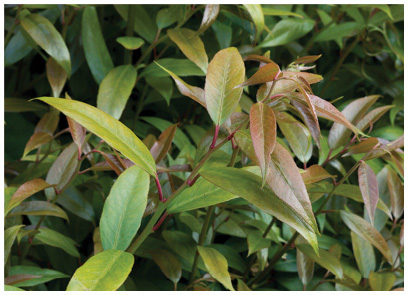
Coast leucothoe (Leucothoe axillaris) A deer-resistant evergreen shrub with a low, arching habit and layered branches densely clothed in leathery dark green leaves. In spring the new growth is a warm bronze shade that contrasts well with the clusters of white flowers. It prefers partial shade but will grow in more sun if well watered. Grows to 2–4 feet tall and up to 6 feet wide in zones 5–8, but you can prune to keep it smaller.
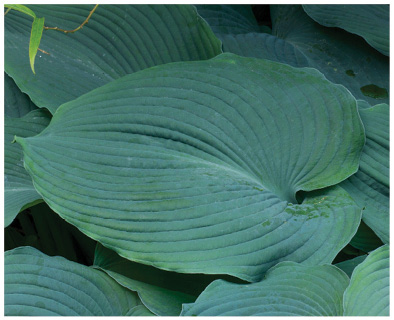
Blue Angel hosta (Hosta ‘Blue Angel’) This hosta needs room to spread. Deeply quilted blue-green leaves and a mounding habit make this a popular perennial for larger shade gardens. Bait for slugs if they are a problem in your area, but this is more resistant than many. Grows to 3 feet tall and 4 feet wide in zones 3–8.

Royal fern (Osmunda regalis) This deciduous fern thrives in moisture-retentive soil and partial or full shade. Tassel-like brown clusters of spores appear at the tips of the fronds. Grows to 3–6 feet tall and 3–4 feet wide in zones 3–9.
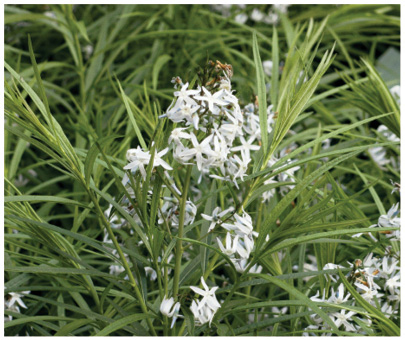
Halfway to Arkansas bluestar (Amsonia ciliata ‘Halfway to Arkansas’) An easy-care, deer-resistant herbaceous perennial grown primarily for its feathery foliage, which turns gold with purple-brown highlights in fall. The starry pale blue flowers that appear in spring are a bonus for many gardeners. Plant in large groups for the best effect. Needs full sun for best fall color but will take light shade. Grows to 2–3 feet tall and wide in zones 5–9.
SITE PARTIAL SHADE, PARTIAL SUN SOIL AVERAGE ZONE 7 SEASON YEAR-ROUND

Three adept players make up this distinctive musical ensemble, each with a unique color and leaf shape. The dramatic and statuesque Corsican hellebore plays the string bass, its deep, resonant tone balanced by the brighter notes from a golden flute expertly fingered by a finely textured yew. Bridging these two is the virtuoso violin, beautifully played by the weigela, which weaves a rich melody and adds definition and support for its fellow artists. One would not expect these three plants to perform so well together, but if any was missing the music would be incomplete.
The dwarf conifer adds interest to this scene year-round with bright golden needles emerging in spring, maturing to an attractive green. Coinciding with the fresh growth, cup-shaped light green flowers appear on the Corsican hellebore, adding a lighter note to the otherwise dull leaves. The dark foliage of weigela buffers these two evergreens, adding bold pink summer flowers to the otherwise subdued color palette. To maintain this balance of height and texture, prune the weigela after flowering and remove the hellebore flowers before they set seed.
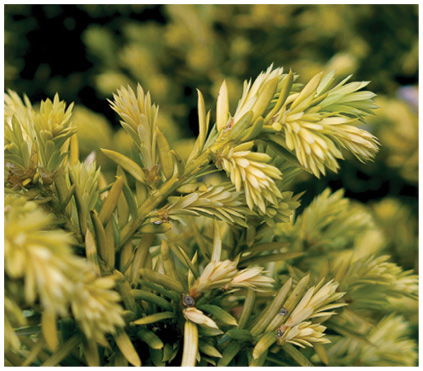
Dwarf golden Japanese yew (Taxus cuspidata ‘Nana Aurescens’) This dwarf, compact golden conifer adds year-round color to the garden. Takes both sun and shade, although it performs best with protection from strong afternoon sun. Grows slowly to 3 feet tall and 5 feet wide in zones 4–7, but will benefit from winter mulch around the root zones in colder climates.
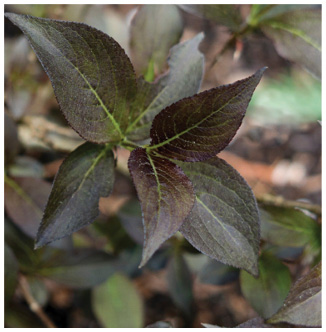
Dark Horse weigela (Weigela florida ‘Dark Horse’) A compact dark-leaved deciduous shrub with tubular pink flowers that hummingbirds love. The best color and flower production occurs in full sun, but it will tolerate light shade. Prune immediately after flowering if needed. Grows to 3 feet tall and wide in zones 4–8.
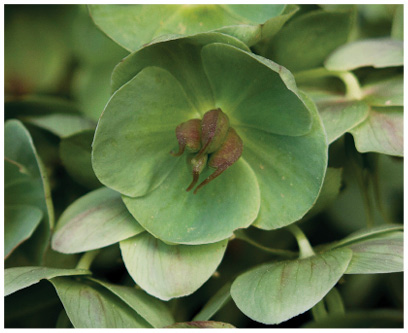
Corsican hellebore (Helleborus argutifolius) An imposing evergreen perennial for the middle of the border with spiny, leathery green leaves and pale green flowers in spring. Corsican hellebore self-seeds readily, so either remove the tired blooms or be prepared to do some judicious thinning. This impressive plant will tolerate sun or partial shade and is adaptable to most soil types, providing they do not become waterlogged. Grows to 3–4 feet tall in zones 7–9; benefits from staking against snow or strong winds.
SITE PARTIAL SHADE SOIL AVERAGE, MOISTURE-RETENTIVE ZONE 5–7 SEASON YEAR-ROUND
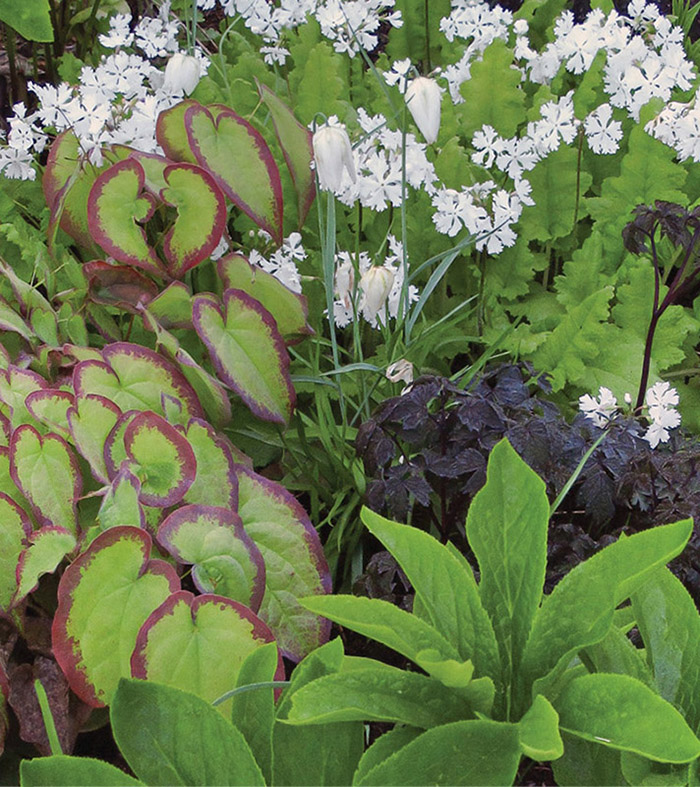
You get the groove of cool jazz in the shade when you combine eye-catching hues and patterns. This refined color scheme starts when the barrenwort strikes the perfect chord with red leaf margins balancing the black dissected bugbane foliage. White primrose blooms lighten and brighten this shady composition, while the fresh green leaves of the hellebore help maintain a steady tempo of evergreen foliage in the melody for the year ahead.
When the romantic new growth and small white flowers on the barrenwort appear in spring, it is only the beginning of this ever-changing display of foliage and flower goodness. Spring’s abundance is apparent when the primrose blooms turn up the volume and beckon you to take a closer look. As they are fading, the rippled green foliage will remain until it finally wanes in the summer heat. To extend the seasonal drama for summer, add a coleus such as ‘Black Prince’, which features a dramatic lime margin on a black leaf. In late winter the hellebore proves its value by energetically budding up for a seasonal show of blooms that will last for weeks.
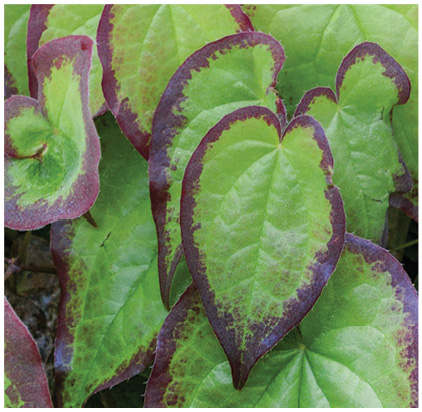
Cherry Hearts barrenwort (Epimedium sempervirens ‘Cherry Hearts’) With such unique growth in spring you may think this evergreen plant is delicate, but that could not be further from the truth. Each heart-shaped leaf emerges light green with a distinctive bright pink outline and sporting a flurry of spurred pure white flowers on 12- to 15-inch-tall stems, making it an outstanding choice for partial shade. When summer arrives the margin will fade to medium green—unless this plant is in a cool, moist location, in which case the pink tones could remain visible through fall. Grows to 12–15 inches tall and 18 inches wide in zones 5–8.
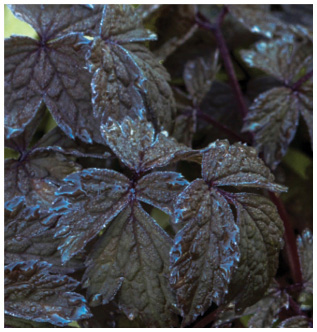
Pink Spike bugbane (Actaea simplex ‘Pink Spike’, also sold as Cimicifuga simplex ‘Pink Spike’) At home in moist, rich soil and bright shade, this perennial fits into any garden style, from contemporary to country. Dark tufts of delicate foliage erupt skyward with airy stems culminating in pale pink spikes of fragrant flowers from August to October that make a dazzling contrast to the foliage. This three-season plant ends with purple-brown foliage in fall. Grows to 3–6 feet tall and 1–3 feet wide in zones 4–8.
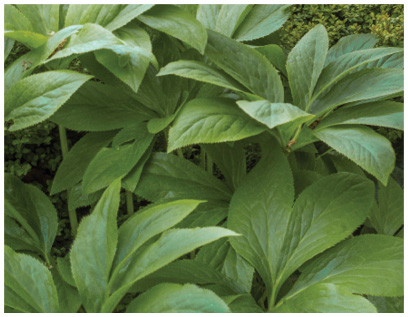
Green Corsican Christmas rose (Helleborus xnigercors ‘Green Corsican’) Nodding single cup-shaped white flowers are abundant on this late-winter-blooming perennial, which is valued for its deer and rabbit resistance as well as the slightly toothed and leathery evergreen foliage that holds up beautifully in tough garden locations. Prefers partial sun to light shade. Grows to 1–2 feet tall and wide in zones 5–8.

Fuji Snow Japanese woodland primrose (Primula sieboldii ‘Fuji Snow’) Emerging in midspring, this delicate-looking yet surprisingly tough perennial is quite impressive. Light green clumps of wavy, spade-shaped foliage give way to 10-inch-tall stalks of distinctive star-shaped white flower clusters that bloom for weeks in light shade. In moist soil, the leaves may remain, while in dry shade the plant will go dormant for the reminder of the year. Grows to 10 inches high and up to 2 feet wide in zones 4–7.
SITE PARTIAL SHADE, PARTIAL SUN SOIL MOISTURE-RETENTIVE POTTING SOIL ZONE 5–8 SEASON YEAR-ROUND

A sophisticated color scheme in a contemporary metallic black pot transforms this petite design into something special. A swathe of fern-like golden foliage tinged with red adds a touch of unexpected glamour to its humbler companions, while the fresh new growth on the spruce brightens the typically dark green conifer. Simple color echoes between the black pot and bugleweed foliage, as well as the repetition of golden yellow leaves with the central ray of the flowers, create a sense of connection. The modest English daisy adds some childlike fun.
Spikes of royal blue bugleweed flowers will soon lend more color to this container design, as all three flowering perennials bloom for several weeks. When the spent flowers are removed in late spring, you may also need to trim the bugleweed foliage to keep it in check. The only limiting factor to long-term enjoyment of this combination is the size of the container, as the plants will outgrow their allotted space within twelve months. However, you can transplant each component to the landscape or to a larger pot and enjoy it for many years.
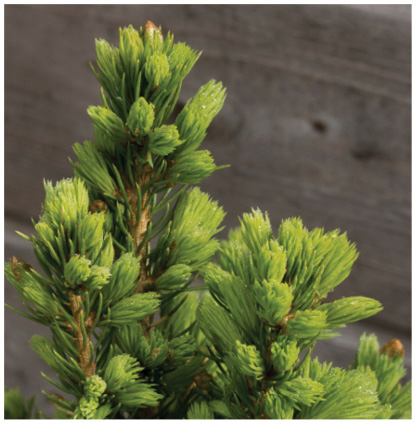
Dwarf Alberta spruce (Picea glauca ‘Conica’) Like a miniature Christmas tree, this very slow-growing evergreen conifer makes a perfect container specimen or landscape plant. Thrives in full sun or partial shade. Grows to 6–8 feet tall and 4–5 feet wide in zones 2–8.

Berry Exciting corydalis (Corydalis ‘Berry Exciting’) This colorful herbaceous perennial will wake up the shade garden with its fern-like golden foliage. Fragrant lavender flowers bloom in spring, but the plant is sterile, so self-seeding is not a concern. Use in containers or as a ground cover, where it will thrive in moisture-retentive soil. Grows to 12 inches high and 18 inches wide in zones 5–8.

Catlin’s Giant bugleweed (Ajuga reptans ‘Catlin’s Giant’) The dark foliage of this spreading ground cover is reason enough to use it, but the spikes of vivid blue flowers in spring make this garden workhorse especially interesting. An evergreen or semi-evergreen perennial, it thrives in moist soil and partial shade, although it will tolerate sunnier conditions if you water it well. Grows to 8 inches tall in zones 4–8; spreads to form extensive clumps that are easy to control.
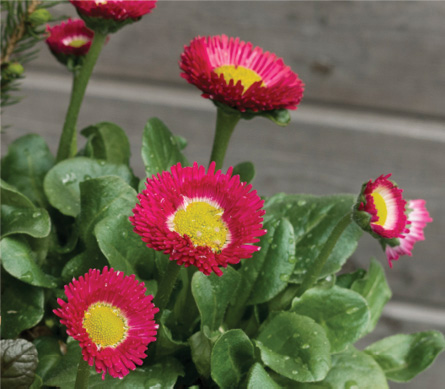
Galaxy Red English daisy (Bellis perennis ‘Galaxy Red’) A charming old-fashioned perennial for spring color, this compact variety blooms with distinctive semi-double daisy-type flowers in sun or partial shade. Remove spent flowers to extend the bloom period. Grows to 8 inches tall and wide in zones 4–8.
SITE PARTIAL SHADE SOIL AVERAGE, MOISTURE-RETENTIVE ZONE 4–8 SEASON SPRING THROUGH FALL
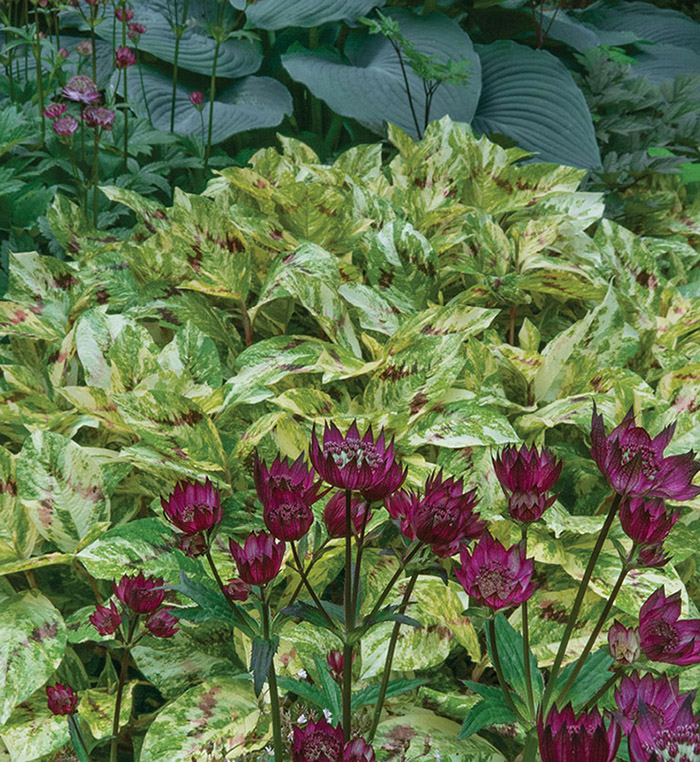
With a masterly sweep of a garden artist’s brush, this designer uses the abstract foliage of Painter’s Palette Virginia knotweed to set the theme, framing the wild splashes and stripes with the bold blue leaves of a hosta. Layered onto this, the crimson flowers of the masterwort appear to leap from the canvas, echoing and highlighting the red tones of the knotweed foliage.
This trio will fill the shade garden with color and texture from spring until fall. The hosta and Virginia knotweed foliage ensure a colorful foundation upon which you can showcase the fall flowers. The red blooms of the masterwort will feature in both spring and fall vignettes, the hosta will add white summer flowers, and in fall the Virginia knotweed will add to the riot of color. A planting of variegated boxwood behind the hosta would add winter interest while repeating the primary colors of the Virginia knotweed. To maintain this balance of foliage and flowers, you may have to prune some self-seeded perennials each spring.
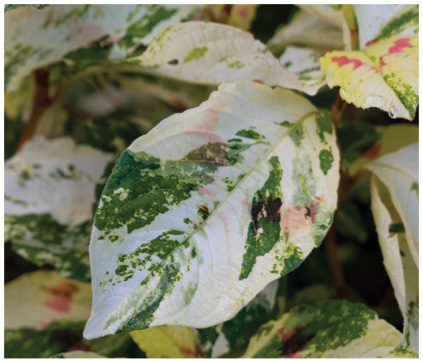
Painter’s Palette Virginia knotweed (Persicaria virginiana ‘Painter’s Palette’, also sold as Tovara virginiana ‘Painter’s Palette’) A colorful herbaceous perennial for the shade garden. The foliage is splashed irregularly with green and cream, and most leaves have a deep red chevron. Painter’s Palette forms a spreading mound of foliage and produces an abundance of unusual red flowers on wiry stems in midsummer. This may spread aggressively by seed and runners in moist soil, so site with care. Grows to 2 feet tall and wide in zones 4–8.
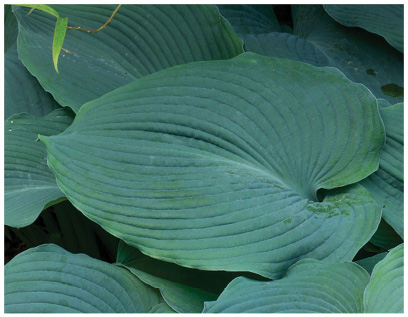
Blue Angel hosta (Hosta ‘Blue Angel’) Heavily textured blue leaves make this hosta a favorite among gardeners, but less so with slugs. Grows to 3 feet tall and 4 feet wide in zones 3–8, with tall spikes of flowers in summer that attract hummingbirds.
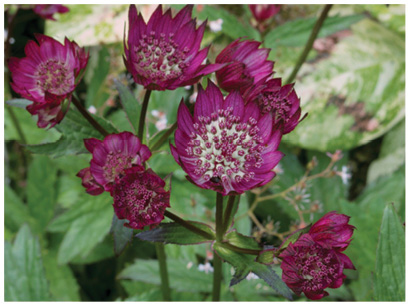
Ruby Wedding masterwort (Astrantia major ‘Ruby Wedding’) Deep red flowers accented with white blooms in spring and often again in fall. The flowers last an exceptionally long time and are excellent for both cutting and drying. This herbaceous perennial does best in partial shade and moisture-retentive soil. Grows to 2 feet tall and wide in zones 3–9.
SITE PARTIAL SHADE SOIL AVERAGE ZONE 9–11 OR ANNUALS SEASON SUMMER

Whether you live in Miami or Michigan, you can get the tropical look with houseplants that love going outside for a summer vacation. A red banana sets the scene, adds instant height, and provides additional shade beneath its huge paddle leaves. Exotic crotons introduce new textures and striking crayon-box colors of yellow, red, orange, and green. For an unapologetic look-at-me punch, you cannot do better than the bright red anthurium. And just when you think you have sensory overload, add fragrant angel’s trumpet to the mix. This vacation goes on and on.
Live for the moment with this foliage-and-flowers extravaganza. Put aside your winter worries and focus on memories of flamboyant summer colors. Don’t worry about deadheading the angel’s trumpet, as the seed heads are equally decorative—just grab your sunglasses and enjoy the show. When temperatures begin to dip in fall, you can bring most of these plants indoors.

Red Abyssinian banana (Ensete ventricosum ‘Maurelii’) This outstanding ornamental banana has foliage flushed with burgundy with dark red midribs, with a deeper color in younger leaves and conditions with more light. May suffer some leaf scorch in full sun, so partial sun to partial shade is ideal, and be sure to protect from strong winds. Grows to 10 feet tall and wide in zones 9–11; is twice as big in the tropics.
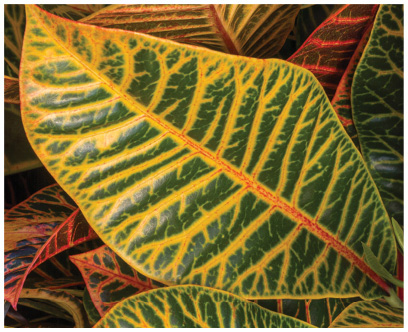
Petra croton (Codiaeum variegatum ‘Petra’) Waxy, vividly variegated foliage with splashes of green, gold, red, and orange make this a colorful choice for the home, summer container, or shade garden. Best grown in partial shade to avoid leaf scorch and maintain vibrancy. Grows to 3 feet tall and wide in zones 10–11 or enjoy as a houseplant or summer annual.
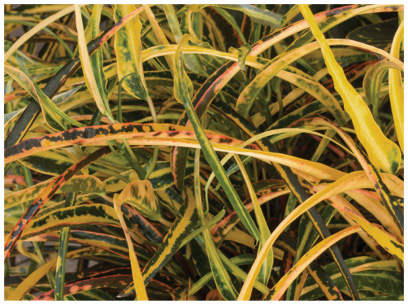
Zanzibar croton (Codiaeum variegatum ‘Zanzibar’) A narrow-leaved cultivar of croton that resembles a colorful grass and has a somewhat straggly mounding habit. Fabulous in shade containers and hanging baskets. Grows up to 2 feet tall and wide in zones 10–11 or enjoy as an annual.
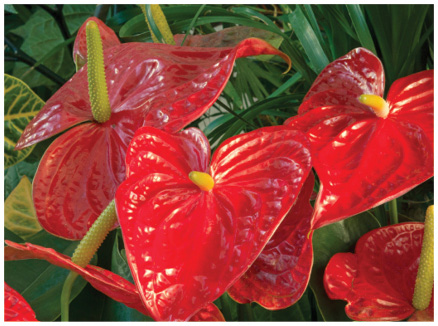
Dakota anthurium (Anthurium andraeanum ‘Dakota’) Grown for its glossy red flowers (actually a spathe or type of bract) with distinctive yellow spadix, this popular houseplant is a bold addition to shade gardens and containers in summer. Grows to 18 inches tall and wide in zones 10–11 or enjoy as an annual.
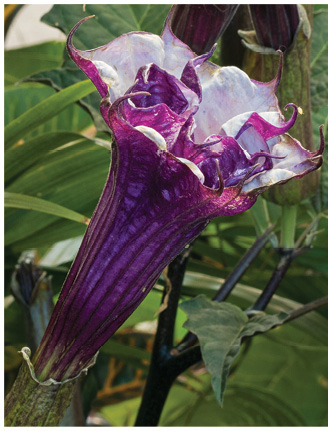
Ballerina Purple angel’s trumpet (Datura metel ‘Ballerina Purple’) Releasing their powerful fragrance at night, the ruffled purple-and-white flowers resemble an elongated trumpet, with 6- to 8-inch-long upward-facing blooms. This compact perennial is perfect for summer containers and landscapes, and prefers full sun (in this scene it is placed beyond the shade cast by the banana). Grows to 3–4 feet tall and wide in zones 9–11 or enjoy as an annual. CAUTION All parts of this plant are highly toxic, so site with care.
SITE PARTIAL SHADE SOIL AVERAGE, MOISTURE-RETENTIVE ZONE 6–8 SEASON YEAR-ROUND
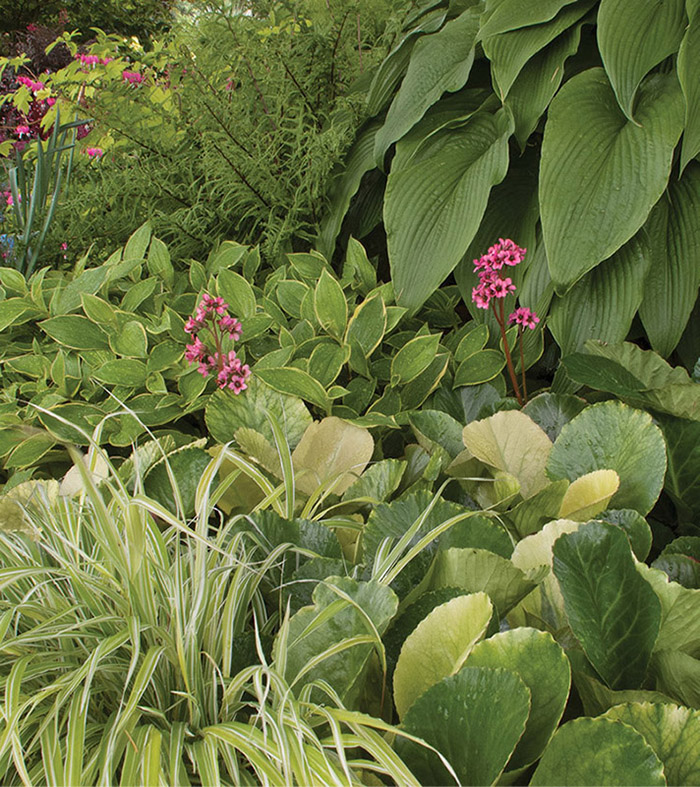
Like an expertly blended cocktail, this citrusy mix has the perfect ratio of sweet and sour. The Lunar Glow bergenia was clearly the inspiration, with large leathery leaves in yellow and green. The Japanese forest grass and golden bleeding heart provide additional lemon flavor, balanced by a squeeze of zesty lime hosta, fern, and toad lily. Top it all off with a decorative pink flower or two and you have a designer cocktail that is sure to become a spring favorite.
Spring through fall offers the most exciting color medley, with both the bleeding heart and bergenia adding pink flowers to the cocktail. In winter the evergreen bergenia will turn burgundy, introducing a new hue into the garden when the perennials are dormant. Underplanting the grass and toad lily with snowdrops would be a lovely way to add contrast to the winter scene, and they would perform well in this partially shady location. As the strappy bulb foliage dies back, the emerging perennials will quickly hide them from view. For ongoing care, you may have to thin out the bergenia occasionally to stop it from overwhelming more delicate plants, but otherwise the perennials should be able to blend easily for many years.
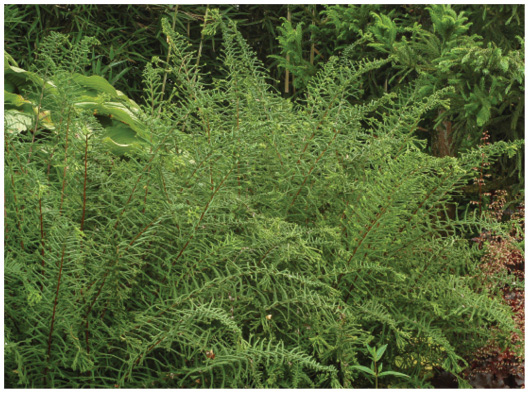
Dre’s Dagger lady fern (Athyrium filix-femina ‘Dre’s Dagger’) This dwarf form of the deciduous lady fern has lacy foliage and thrives in moist woodlands in partial or full shade. Grows to 18 inches tall and wide in zones 4–8. Crested lady fern (A. filix-femina ‘Vernoniae Cristatum’) is a reliable performer and may be easier to find.

Hosta (Hosta species) While the name of this hosta has been forgotten, any of the taller solid green or green-blue varieties would work well, like Miss American Pie or Krossa Regal. Most hostas prefer moist and semi-shaded conditions, will need baiting for slugs, and are hardy in zones 3–9.
Stripe It Rich variegated Japanese forest grass (Hakonechloa macra ‘Stripe it Rich’) This herbaceous grass cascades into a soft yellow waterfall, each golden blade lightly striped with white. Grows to 10 inches tall and 20 inches wide in zones 6–9.

Gilt Edge toad lily (Tricyrtis hirta ‘Gilt Edge’) An easy herbaceous perennial for the shade garden. The green leaves are edged with gold, and in midsummer freckled purple flowers appear. Grows to 2 feet tall and 12 inches wide in zones 5–9.
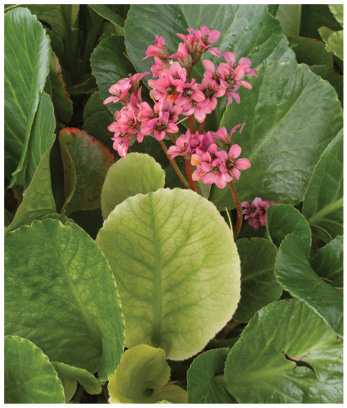
Lunar Glow bergenia (Bergenia ‘Lunar Glow’) This evergreen perennial is worth looking for. The new foliage opens creamy yellow, matures to green, and turns burgundy in winter, often resulting in a multicolored effect. Fat spikes of pink flowers appear in spring. Grows to 12 inches tall and 18 inches wide in zones 4–9.

Gold Heart bleeding heart (Dicentra spectabilis ‘Gold Heart’) This herbaceous perennial is a colorful addition to the shade garden, with apricot-pink stems, pure gold leaves, and rose-pink spring flowers. Grows to 2–3 feet tall and wide in zones 3–9.
SITE PARTIAL SHADE, PARTIAL SUN SOIL AVERAGE ZONE 5–8 SEASON SPRING THROUGH FALL

Like a child’s dot-to-dot puzzle, the blue star creeper connects every plant along the shaded pathway, from the towering purple smoke bush, bold-leaved hosta, and wispy willow to the tiny ferns. Without this linking thread, the shrubs and perennials could appear as attractive specimens but isolated from one another. But as the tightly woven carpet of blue star creeper meanders between flagstones, the plant collection is united and the journey heightened as visitors are encouraged to stroll leisurely along the path and explore.
From spring until fall this garden path will be a delight of foliage and flowers, unified by the diminutive blue star creeper. In fall the perennials will become dormant and deciduous shrubs will lose their foliage, leaving just the semi-evergreen ground cover to add color during the winter. Interspersing the perennials with some evergreen sweetbox (Sarcococca ruscifolia) would add fragrance in January and glossy green leaves year-round.
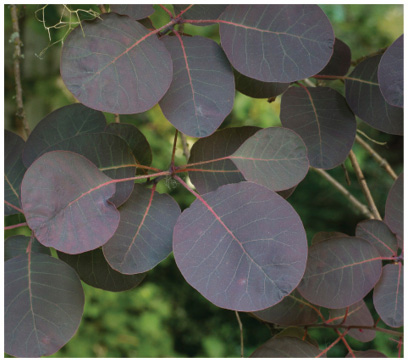
Smoke bush (Cotinus coggygria) Trained over many years to grow as a single-trunked tree, this is most likely a seedling of Royal Purple. Striking purple foliage will turn scarlet in fall, while smoky flower plumes add an ethereal touch in summer. Prefers full sun to partial shade. Grows to 10–15 feet tall and wide in zones 5–9, but you can prune to keep it smaller.
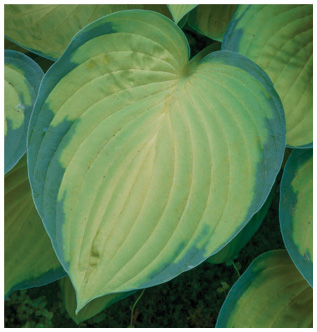
Gold Standard hosta (Hosta ‘Gold Standard’) Hand-size richly textured leaves and bold variegation make this a popular addition to the shade garden. Leaf centers emerge light green in spring, turning progressively gold throughout the summer. In summer this herbaceous perennial mound produces tall spikes of lavender flowers that attract hummingbirds. Grows to 3 feet tall and wide in zones 3–8.
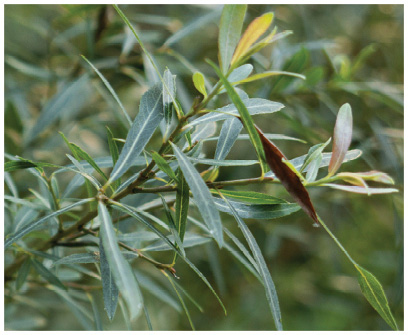
Dwarf blue arctic willow (Salix purpurea ‘Nana’) Featuring slender blue stems and very narrow blue-green leaves, this deciduous shrub thrives in wet soil. Winter catkins add interest before the new leaves appear. Grows to 5 feet tall in zones 4–8, but is best pruned shorter to keep a compact form.

Blue star creeper (Isotoma fluviatilis) Preferring moisture-retentive soil and partial sun, this fast-growing ground cover will quickly carpet the ground with a mat of tiny green leaves. It is ideal for edging ponds and pathways. Starry light blue flowers appear in early summer, often with sporadic repeat bloom. This vigorous perennial may be evergreen or semi-evergreen. Grows to 2 inches high in zones 5–9.
SITE PARTIAL SHADE, PARTIAL SUN SOIL AVERAGE ZONE 6–9 SEASON YEAR-ROUND
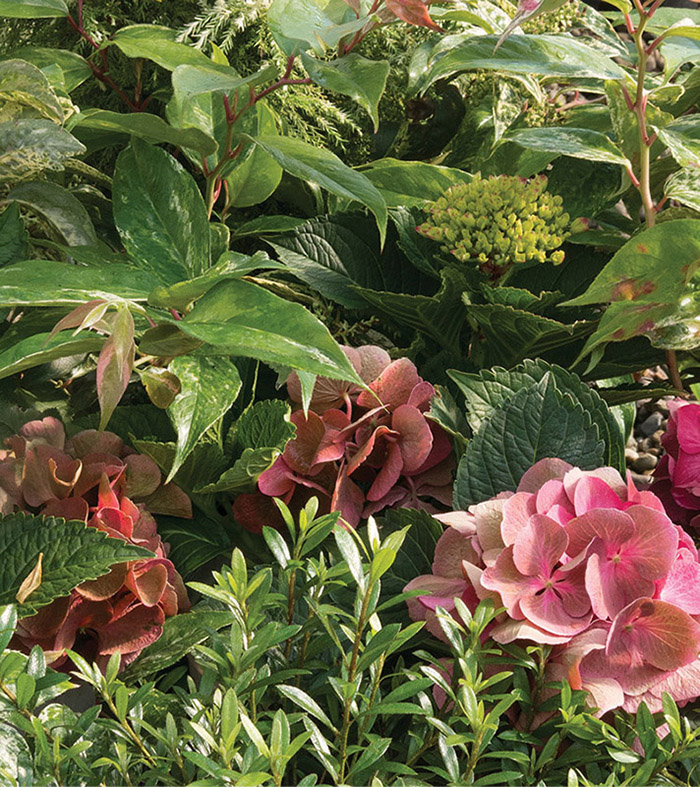
How do you enhance an already beautiful flowering shrub? Frame it with foliage to extend the interest through the year and highlight it when in full bloom. The soft pink stems and new growth on the leucothoe are the ideal shade to echo the hydrangea flowers, while the smaller-leaved azalea emphasizes the shrub’s bolder foliage. This is a big-look combination for even small gardens, given that the hydrangea is a compact variety, the azalea is a dwarf ground cover, and the leucothoe is easily pruned for shape and size.
Planted this close together the leucothoe will need regular trimming to allow the hydrangea room to grow, but that is easy to do. As the hydrangea matures it will assert itself between the taller shrub and ground cover. During the winter the leucothoe will turn deep red, followed in spring by white flowers. This is when the azalea will also begin to bloom with its primary flush of orange-red flowers.

Rainbow leucothoe (Leucothoe fontanesiana ‘Rainbow’) This evergreen arching shrub has waxy leaves splashed with creamy yellow, pink, and green, with deep red added to the mix in winter and creamy flowers in spring. Prefers partial shade to full shade, but can take more sun in moisture-retentive soil. Grows to a 5-foot mound in zones 5–9, but you can prune to keep it smaller.
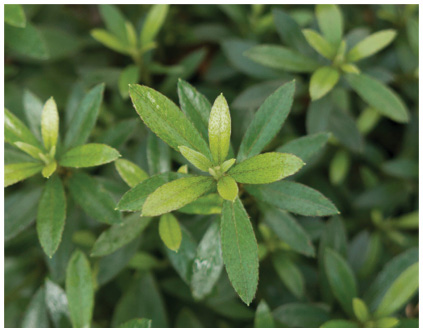
Flame Creeper azalea (Rhododendron ‘Flame Creeper’) This dwarf evergreen azalea has more of a ground cover habit than most. Red-orange flowers pop up in spring and continue to appear sporadically through summer and fall, set off nicely by the small glossy green leaves. Does best in partial shade and acidic, moisture-retentive soil. Grows to 12 inches tall and 2–3 feet wide in zones 6–9.
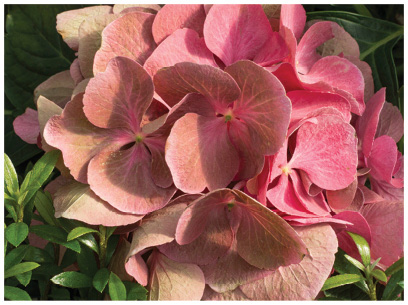
Cityline Paris hydrangea (Hydrangea macrophylla ‘Cityline Paris’) This petite shrub still packs a lot of color and does not need pruning. Large mophead-type flowers open fuchsia, fade to duskier tones, and finally soften to light green, giving an overall multihued effect to the bush. Use this in a container or as part of a mixed border in the landscape. Prefers partial shade to partial sun. Grows to 3 feet tall and wide in zones 5–9.
SITE SHADE, PARTIAL SHADE SOIL AVERAGE ZONE 6–8 SEASON YEAR-ROUND
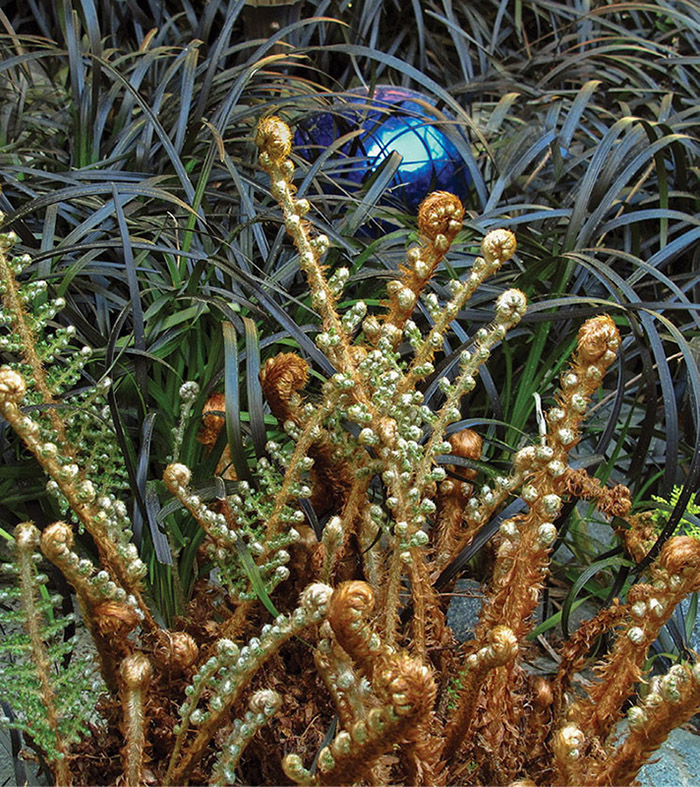
Take one seemingly pedestrian plant like the robust western sword fern, add the star power of black mondo grass and a piece of glass art, and this ensemble of players is automatically elevated in sophistication. The delicate bronze fiddleheads of the fern are worthy of adoration for the geometric details alone, while the nearly black grass garners applause for its stout yet graceful growth and strong color. Electric blue reflective glass highlights each actor to spotlight status for their dynamic individual performances as well as what makes them shine as a trio.
A captivating combination like this one is ready for the paparazzi any time of the year, giving a slightly different look depending on the season. Once the fern has unfurled in spring to reveal tall verdant fronds, it turns to deep green for summer—just as the mondo grass nestled at its base begins to bloom. The mirror-like blue orb is superb for reflecting the perfectly shiny black berries that follow the flowers on the mondo grass in late summer and fall. For winter interest, both the fern and mondo grass are evergreen performers. If you live in a mild climate, leave the glass out to provide enjoyment on cool frosty days.
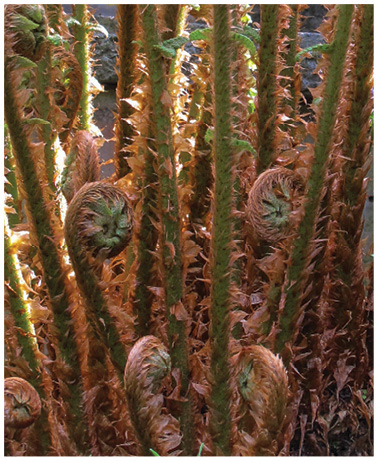
Western sword fern (Polystichum munitum) Native to the Western United States, this reliable and texturally interesting fern has lush bright green spring growth that turns dark and leathery in summer. To keep it looking tidy, prune off winter-damaged fronds in early spring before new growth appears. This easy plant is suited to shady woodland settings, but once established it will tolerate dry soils under large trees. Grows to 4 feet tall and wide in zones 5–9.
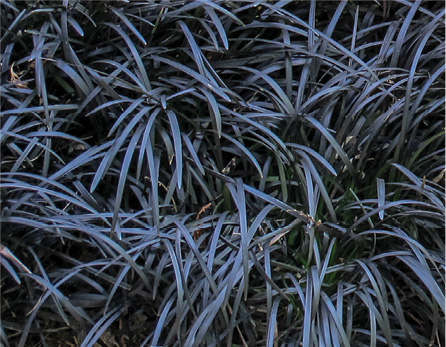
Black mondo grass (Ophiopogon planiscapus ‘Nigrescens’) Dense purple-black tufts of evergreen foliage are low growing and perfect for the front of the border or containers. Bell-shaped lavender flowers turn into glossy black berries in fall. This slow-spreading grass does well in partial to full shade, but tolerates more sun with consistent watering. Grows to 5–6 inches tall and wide in zones 6–10.
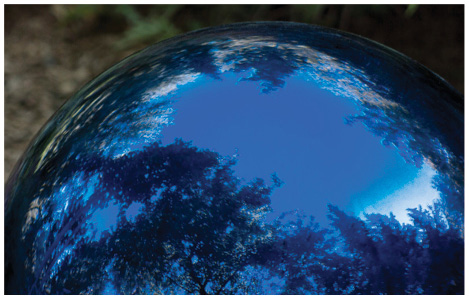
Gazing balls are frequently placed on pedestals in the garden so they are at an easier height for viewing, but when nestled among the foliage they beckon you to bend down and admire the reflections. The electric blue color of this gazing ball is particularly interesting paired with the striking black mondo grass in lower light.
SITE PARTIAL SHADE, SHADE SOIL AVERAGE, MOISTURE-RETENTIVE ZONE 4–8 SEASON YEAR-ROUND
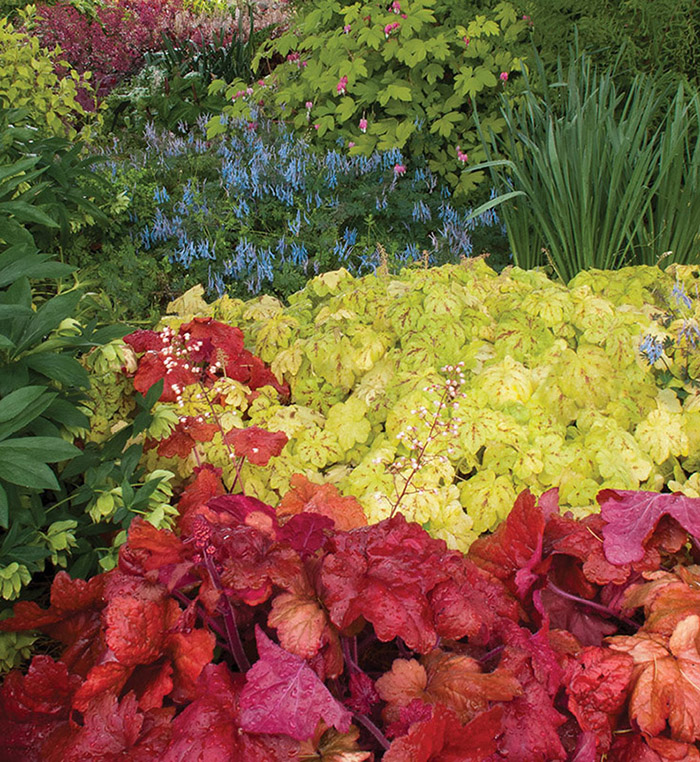
Celebrate spring with some bright, juicy foliage to light up your shade garden. Woven like a patchwork quilt, these plants fuse together effortlessly, yet each leaf shape remains distinct. The color echo between the fiery coral bells and the pink flowers of the bleeding heart with the repetition of golden foliage shows a well-thought-out design with great attention to detail. Introducing an unexpected pop of blue adds the fun factor. This combination of bold color and big textures makes the heart race a little faster—it must be spring fever.
Although this is a combination of perennials, the hellebore and foamy bells are evergreen. Only the bleeding heart and corydalis will die down for the winter; underplanting these with daffodils will bridge that gap in early spring. Fire Alarm heuchera has not been a reliable winter survivor in the Pacific Northwestern United States; Fire Chief promises to be a better option for this climate. Over time the clumps of corydalis, bleeding heart, and hellebore will continue to expand but intermingle easily, without the need for dividing and replanting.
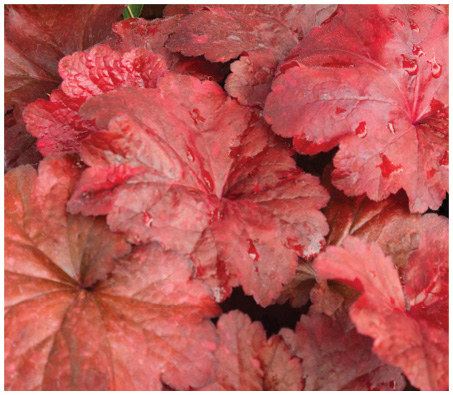
Fire Alarm coral bells (Heuchera ‘Fire Alarm’) This fiery hybrid will ignite your containers and gardens. The large, smooth leaves transition through shades of deepest mahogany to bright red during the year. The most vivid colors appear in spring, when tall stems of airy white flowers add to the spectacle. Evergreen in milder climates, this showstopper is still worth growing for three-season interest elsewhere. Prefers partial shade. Grows to 14 inches tall and wide in zones 4–9.
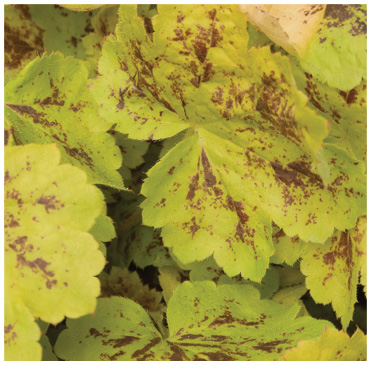
Solar Power foamy bells (Heucherella ‘Solar Power’) Bright yellow leaves are splashed with deep red, the perfect marriage of colors for this design. In the north this evergreen perennial does well in full sun, but it prefers afternoon shade in hotter climates. Grows to 12 inches tall and 20 inches wide in zones 4–9.
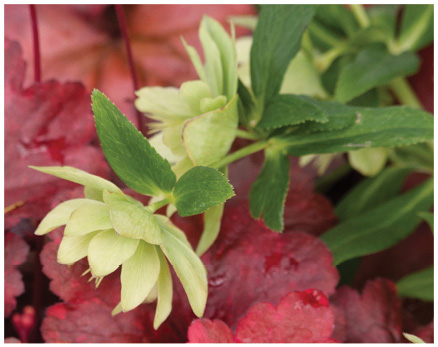
Golden Lotus hellebore (Helleborus xhybridus ‘Golden Lotus’) The evergreen foliage and pale frilled flowers add a soothing note to the combination. Each double flower may be a slightly different shade of yellow; some have a pink picotee edge and back. Like most hellebore the blooms fade to a soft green. Grows to 12 inches tall and 2 feet wide in zones 5–8.
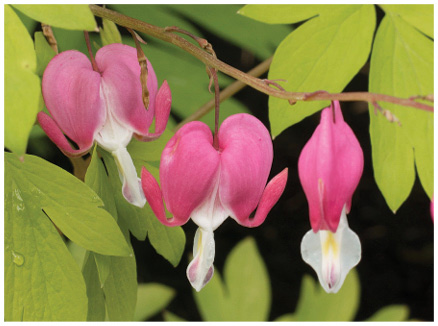
Gold Heart bleeding heart (Dicentra spectabilis ‘Gold Heart’) The fern-like golden foliage of this herbaceous perennial acts as a spotlight in the shade garden. Tall arching stems emerge in spring, from which rows of perfect pink heart-shaped flowers dangle. Bleeding heart will grow in dry shade, but more moisture-retentive soil will encourage healthier and longer-lasting foliage. Grows to 2 feet tall and 3 feet wide in zones 4–8.

China Blue corydalis (Corydalis ‘China Blue’) The blue-toned leaves of this herbaceous perennial highlight the abundant, fragrant light blue flowers that appear in spring and sometimes in fall. Appreciates moisture-retentive soil. Grows to 12 inches tall and 8 inches wide in zones 5–8.
SITE PARTIAL SHADE, PARTIAL SUN SOIL AVERAGE ZONE 6–8 SEASON YEAR-ROUND
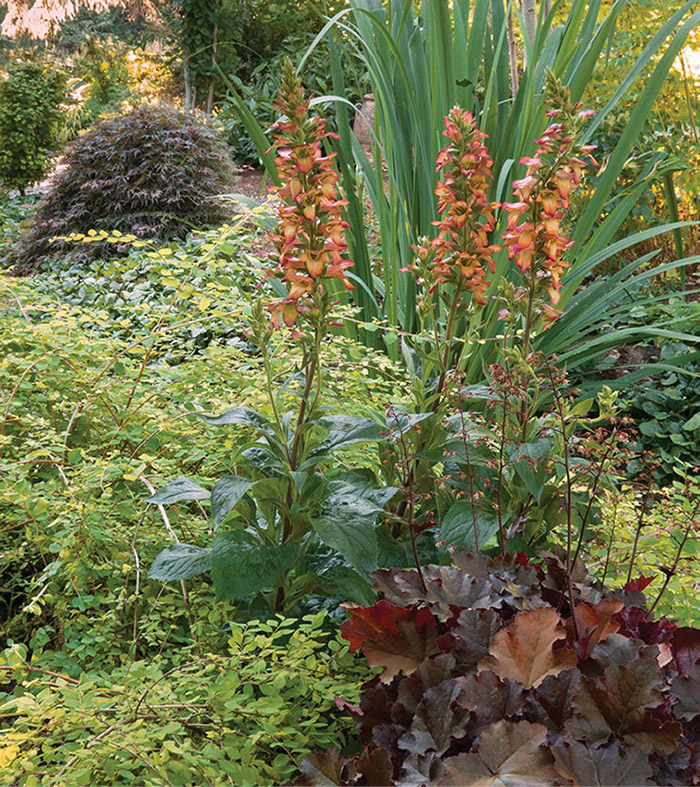
A delightful combination for dappled shade, this design will offer an ever-changing display of colorful foliage, flowers, and berries, each season introducing a new blend. The warm burnished bronze coral bells repeats the form and color of the distant cascading maple, while tall spikes of foxglove-like orange flowers punctuate the undulating golden ground cover and echo the vertical lines of the iris. Together they allow for seasonal interest throughout the year.
Spring foliage colors in this woodland range from the bright orange-red maple and purple coral bells to the golden snowberry, highlighted by bright yellow iris blooms. By summer the colors have matured to richer shades that frame the glowing digiplexis flowers, which appear over several months. Fall sees a return to more brilliant crimson, orange, and gold as the deciduous shrubs prepare for their last hurrah, accented with metallic pink berries on the snowberry. Only the coral bells will provide reliable winter foliage interest as the garden waits for the next merry-go-round ride to begin.
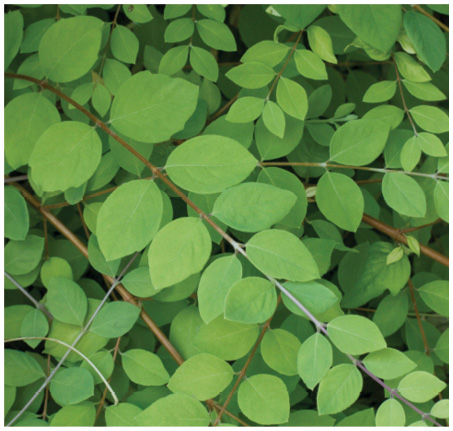
Blade of Sun snowberry (Symphoricarpos chenaultii ‘Blade of Sun’) An outstanding deciduous ground cover for the shade garden with wide-spreading branches that form dense layers of golden foliage. Emerging brilliant yellow, the color fades to chartreuse in summer and in heavier shade, returning to gold in fall when metallic pink berries make the color even more exciting. Grows to 1–2 feet tall and 3 feet wide in zones 4–9, but branches may root as they touch the ground, encouraging an ever-expanding spread.
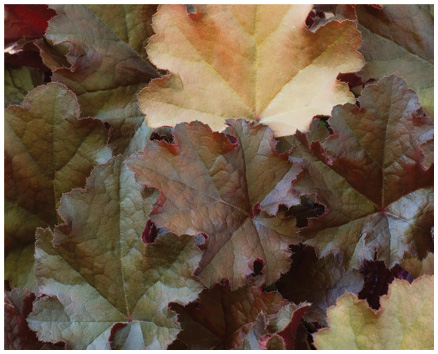
Mahogany coral bells (Heuchera ‘Mahogany’) Flushed with shades ranging from dark brown to light and changing with the seasons, this foliage will always add a rich luster to combinations. Cream-colored summer flowers add to the display and attract hummingbirds. This evergreen perennial tolerates full sun but does best in partial shade to partial sun. Grows to 8 inches tall and 14 inches wide in zones 4–9.
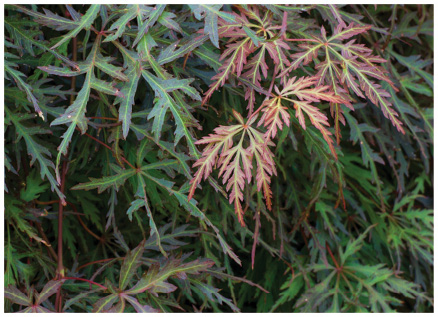
Orangeola Japanese maple (Acer palmatum ‘Orangeola’) Noted for its bright orange-red spring growth and fiery colors in fall, the deeply dissected foliage of this maple forms a cascading mound and continues to erupt with bright color throughout the summer. Prefers full sun to partial shade. Grows to 8 feet tall and 7 feet wide in zones 6–9.
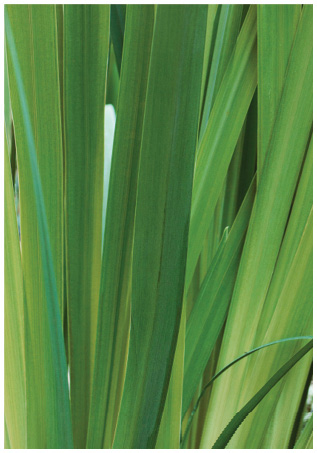
Yellow flag iris (Iris pseudacorus) Thriving in wetlands, shallow water, or moisture-retentive soil, this rhizomatous semi-evergreen perennial blooms with yellow flowers in spring followed by fat glossy seed capsules. Spreads easily, so you may need to thin annually. Prefers full sun to partial shade. Grows to 4–6 feet tall in zones 4–8. CAUTION This is classed as a noxious weed in many areas, so consult your local extension office before planting.
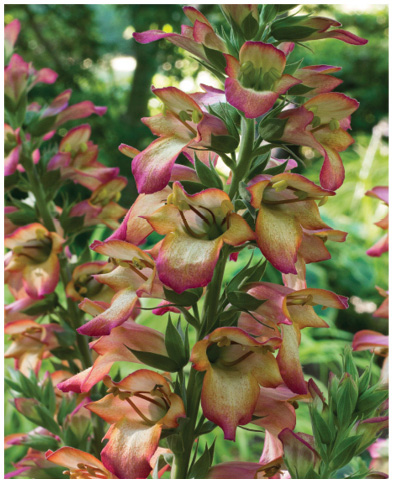
Illumination Flame digiplexis (Digiplexis ‘Illumination Flame’) A cross between a foxglove and its Canary Island cousin, this new introduction has been causing quite a stir in the gardening world. Vibrant orange and fuchsia-pink tubular flowers are sterile, so instead of trying to set seed the plant just keeps on blooming throughout the summer. Seems to do best in partial sun to partial shade, but is adaptable to full sun if you water it well. Grows to 3 feet tall and 2 feet wide in zones 8–10, but you will still want this as a colorful annual if you live in a cooler climate.
SITE SUN, PARTIAL SUN SOIL AVERAGE ZONE 5–9 SEASON SPRING THROUGH FALL

Did you hear? Green is the new black—specifically shades of lime or chartreuse because they work so well with everything. In this design, the citrus tones of the Japanese forest grass and lacy golden feverfew are nearly matched in color, although not in texture, and provide a backdrop for the sweet white feverfew daisy flowers. The blue-green foliage of the lady’s mantle contributes some contrast and a bit of weight to this fluffy combination.
The emergence of the radiant foliage on the feverfew is a beacon of light in the shade garden right when we need those buoyant and energetic colors to sparkle for spring and summer. As the summer temperatures rise, the lady’s mantle sets frothy sprays of chartreuse blossoms. When those blooms fade, the feverfew daisies open for their time in the sun, sparkling from summer through fall.

Lady’s mantle (Alchemilla mollis) Velvety blue-green leaves on this enchanting old-fashioned perennial hold water droplets that sparkle like tiny jewels. Clusters of tiny pale yellow flowers are held above the summer foliage, but shear them off to prevent self-seeding. Happy in full sun to partial shade. Grows to 12 inches tall and 2 feet wide in zones 4–9.

All Gold Japanese forest grass (Hakonechloa macra ‘All Gold’) A graceful clumping ground cover grass with bold chartreuse color and the appearance of bamboo. This hardy perennial does well in partial shade to partial sun and is ideal in containers or as a color accent in borders. Grows to 2 feet tall and wide in zones 4–9.
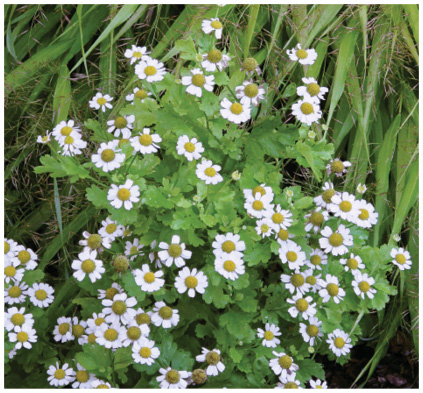
Golden feverfew (Tanacetum parthenium ‘Aureum’) Aromatic golden foliage on this herbaceous perennial shines brightest in full sun but also does well in partial shade. In summer, small white daisies add sparkle, but deadhead them if you want to avoid self-seeding. Grows to 2 feet tall and wide in zones 5–9.
SITE SHADE, PARTIAL SHADE SOIL AVERAGE ZONE 6–8 SEASON YEAR-ROUND
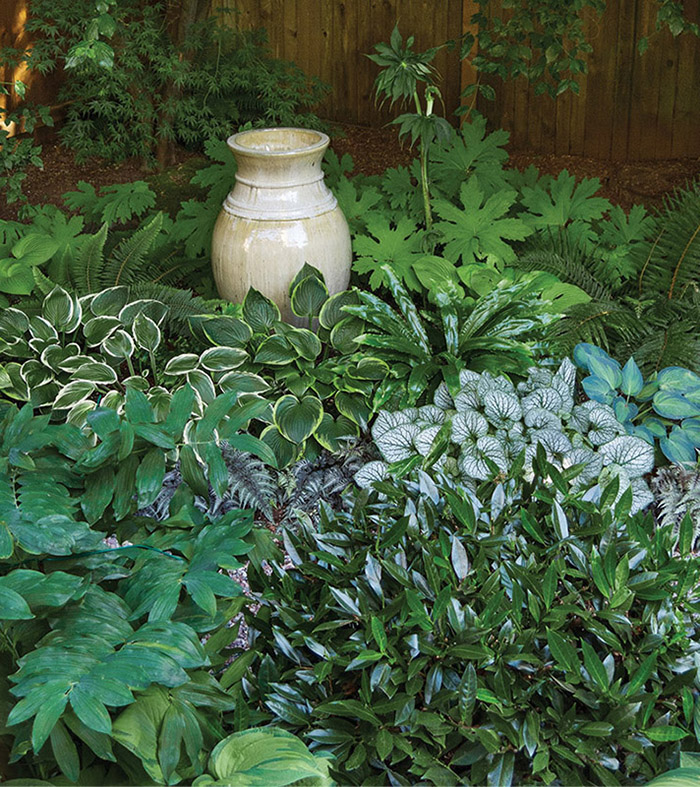
Transform a shady spot under towering evergreens by incorporating shiny surfaces and pale colors. This glossy ivory urn sits in a spot where tree roots make it challenging to grow many plants. In the more hospitable ground in front of the container are layered foliage plants that either reflect the light (Hart’s-tongue fern) or have a bright color (silver Jack Frost Siberian bugloss). A complex tapestry of interesting leaf shapes, colors, and patterns has been woven into a lush design. Just like magpies, we are naturally drawn to shiny objects, and this carefully orchestrated vignette is irresistible.
Most of these plants are herbaceous perennials, so in winter there will be very limited foliage interest around the urn. However, this part of the garden is rarely visited in the colder months, so it can be allowed to rest. A mass planting of Siberian squill (Scilla siberica) would be a lovely way to add early spring interest, as the blue or white flowers can naturalize in the shady conditions between the hostas and ferns.
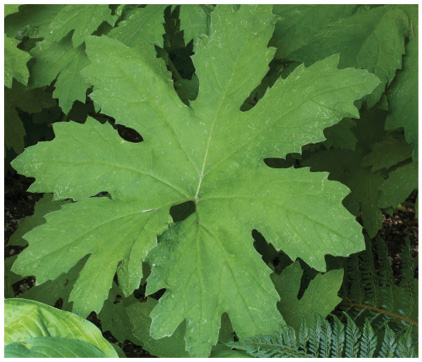
Western coltsfoot (Petasites palmatus) Not for the faint of heart, this large-leafed shade-loving perennial can quickly become invasive in moist soil. Careful monitoring and a barrier of drain rock maintain the status quo in this garden, but you may wish to substitute Rodger’s flower (Rodgersia aesculifolia). This plant flowers in spring with leaves that may be 12 inches in diameter. Grows to 2 feet tall and 3 feet wide in zones 6–10.
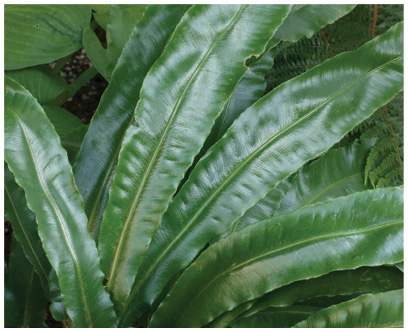
Hart’s-tongue fern (Asplenium scolopendrium) The broad, strap-like fronds are bright green and appear polished to a rich sheen. On the undersides the red-brown spores create a distinctive striped pattern. Prefers shade or partial shade. Grows to 20 inches tall and wide in zones 6–9.
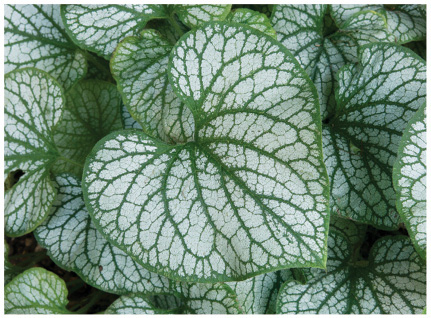
Jack Frost Siberian bugloss (Brunnera macrophylla ‘Jack Frost’) One of the first perennials to leaf out in spring and one of the last to go dormant, this earns its place in the shade garden. This drought-tolerant, deer-resistant plant has heart-shaped leaves overlaid with an intricate silver netting, and in spring forget-me-not-type flowers add to the display. Grows to 12 inches tall and 18 inches wide in zones 3–8.
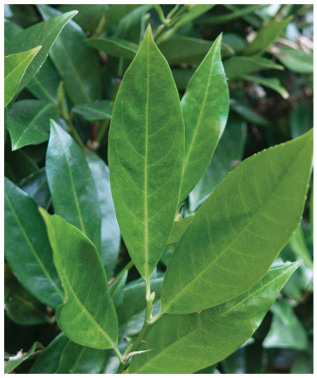
Otto Luyken English laurel (Prunus laurocerasus ‘Otto Luyken’) This low-growing evergreen shrub has glossy deep green leaves and fragrant white flowers in spring. Prefers full sun to partial shade. Grows to 3 feet high and 6 feet wide in zones 6–9, but you can prune to keep it smaller.
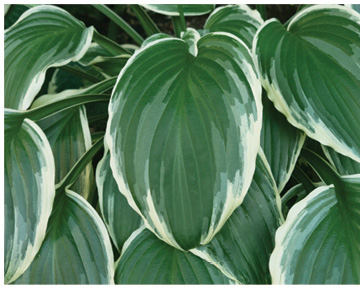
Francee hosta (Hosta ‘Francee’) A compact mound of bold green-and-white variegated leaves adds sparkle to the shade garden. Grows to 2 feet tall and 4 feet wide in zones 4–8.

Frances Williams hosta (Hosta sieboldiana ‘Frances Williams’) Classic heart-shaped leaves with green-and-gold variegation form a large mound. Grows to 2 feet tall and 5 feet wide in zones 3–8.
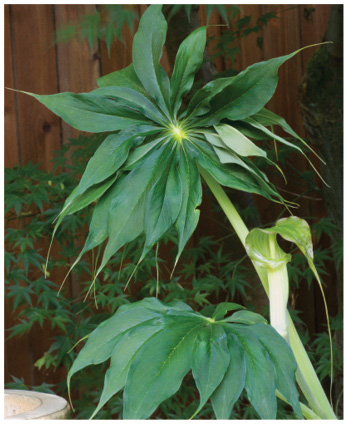
Jack-in-the-pulpit (Arisaema species) The exact identity of this herbaceous woodland bulb is uncertain, but it appears to be Himalayan Jack-in-the-pulpit (A. consanguineum), which flowers in June with unusual hooded blooms sometimes followed by orange-red berries. The palmate foliage is attractive from spring until fall. Grows to 3 feet tall and 12 inches wide in zones 5–9.
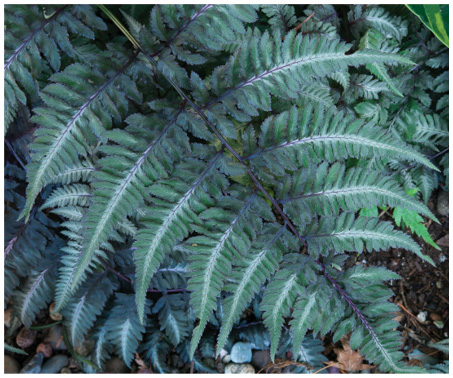
Japanese painted fern (Athyrium niponicum var. pictum) A true standout in the woodland garden, the delicate feathery foliage appears to be gilded with silver, while the stem and veins are typically burgundy. Grows to 18 inches tall and wide in zones 4–9.

Solomon’s seal (Polygonatum xhybridum) Use this perennial to add height to the shade garden. In late spring, dangling pairs of creamy white flowers hang from the arching stems. Drought tolerant and deer resistant. Grows to 4 feet tall and 3 feet wide in zones 3–8.
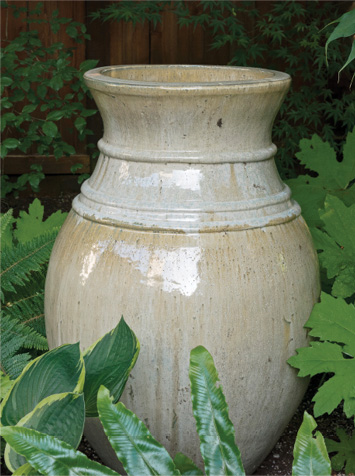
Ivory urn An oversize curvaceous vessel with a high gloss finish makes a statement and distracts the eye from the challenging area behind it, where even weeds struggle to grow.
SITE PARTIAL SHADE, PARTIAL SUN SOIL AVERAGE ZONE 7–8 SEASON YEAR-ROUND
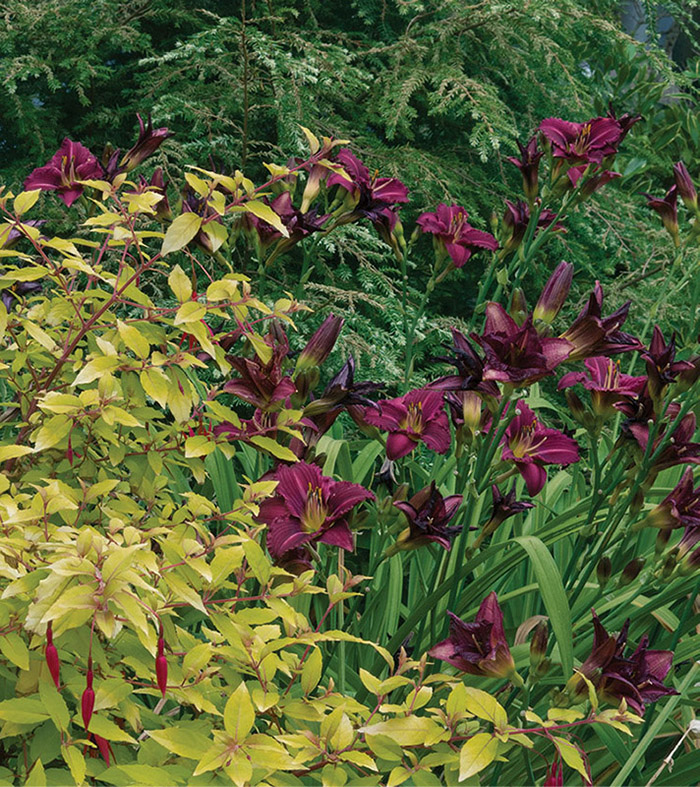
While the evergreen variegated hemlock provides year-round color and structure, the golden leaves of the fuchsia really steal the foliage show and light up this shady border. Sandwiched between the two, the purple flowers of the dwarf daylily introduce a new color, while their yellow throats echo the color of the fuchsia leaves. Completing the scene, the hardy fuchsia produces dangling magenta and purple blooms from midsummer until fall, attracting hummingbirds and linking back to the color of the daylilies. Using golden foliage to brighten shade gardens is a well-known designer trick, but this combination makes the most of an opportunity to incorporate some warm violet tones as well.
With its repeat-blooming habit, the daylily will continue to contribute colorful flowers to this scene until autumn, at which time it typically goes dormant (although in mild winters it can remain evergreen). The fuchsia is deciduous, so only the hemlock will provide reliable color and interest in winter. The addition of a carpet of evergreen black mondo grass (Ophiopogon planiscapus ‘Nigrescens’) would extend this, and would also look especially striking against the fuchsia foliage when it re-emerges in spring.
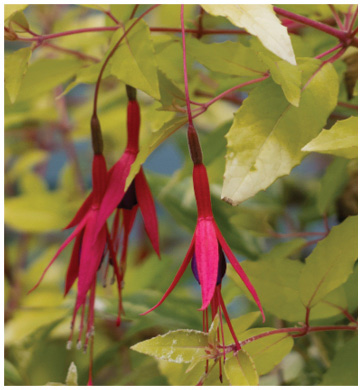
Hardy fuchsia (Fuchsia genii) This deciduous shrub makes a bold statement with its golden foliage and pendulous magenta and purple flowers. Protect from hot afternoon sun to prevent leaf scorch and wait until all danger of frost has passed before pruning in spring. Grows to 4 feet tall and wide in zones 7–9.
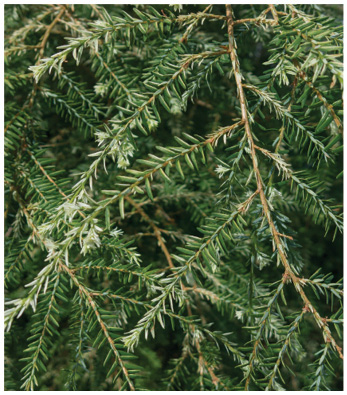
Gentsch White Canadian hemlock (Tsuga canadensis ‘Gentsch White’) A special conifer for partial sun to partial shade with a layered, lacy habit and distinctive white tips on the new growth. This evergreen prefers regular watering, especially in summer. Grows to 4 feet tall and wide or more in zones 3–8, but you can prune to keep it more compact, which will also improve the coloring.
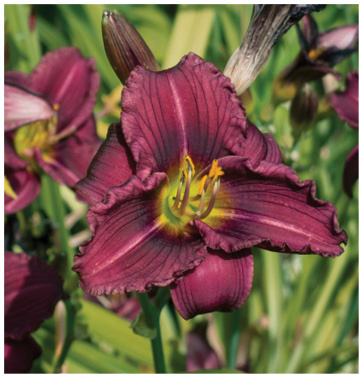
Little Grapette daylily (Hemerocallis ‘Little Grapette’) Purple flowers with distinctive golden throats appear throughout the summer on 20-inch-tall stems held high above the grass-like foliage. While naturally blooming in several waves, remove old flowers and stalks to encourage reblooming. This low-maintenance perennial may be evergreen in mild winters and prefers full sun to partial shade. Grows to 18 inches wide in zones 4–10; you can divide easily.
SITE PARTIAL SHADE, PARTIAL SUN SOIL AVERAGE ZONE 5–8 SEASON YEAR-ROUND

The garden is awake and ready for action. Dangling creamy white flowers and new red-brown foliage on the andromeda hang over heart-shaped barrenwort leaves and blades of moor grass as they push out supple new growth for the year. The unique bronze-and-green veining on the barrenwort foliage surges up to obscure the fading yellow blooms that were the stars of this trio in early spring, while the fluffy grass sends up spiky new growth in complementary buttery tones that unite them all.
Midspring warmth energizes this scene into a new growth frenzy when rust-colored leaves stand out against the warm white of the andromeda flowers, staying for weeks on end while the young leaves of the barrenwort and moor grass show off their new adolescent colors. Quieting down for the warmer months, all but the moor grass turn to rich summer green. Adding the spiky zing of Red Sentinel Japanese astilbe (Astilbe japonica ‘Red Sentinel’) would bring a bold splash of summer color and an extra layer of textural foliage interest.
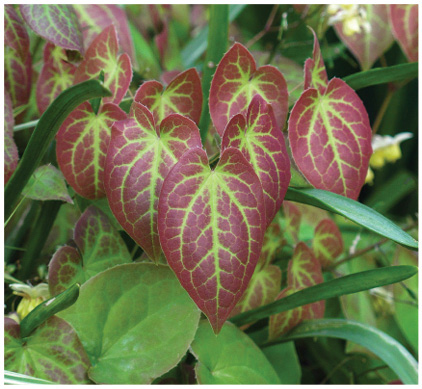
Sulphureum barrenwort (Epimedium versicolor ‘Sulphureum’) Before new heart-shaped foliage emerges with defined bronze markings, lovely spurred yellow flowers top stems reaching 8–12 inches tall. Valued for its evergreen foliage, this ground cover is perfect at the border’s edge in partial to full shade, or in woodland areas. Rabbits and deer do not enjoy this menu item. Grows to 12 inches tall and 2 feet wide in zones 5–9.

Variegated purple moor grass (Molinia caerulea ‘Variegata’) Striped blades of creamy yellow-and-green grass form a soft, arching mound with purple seed heads in summer. In the summer breeze, this grass provides lovely movement in the garden and looks wonderful through the fall before you cut it back for winter. Prefers full or partial sun and average soil. Grows to 3 feet tall and 2 feet wide in zones 4–9.
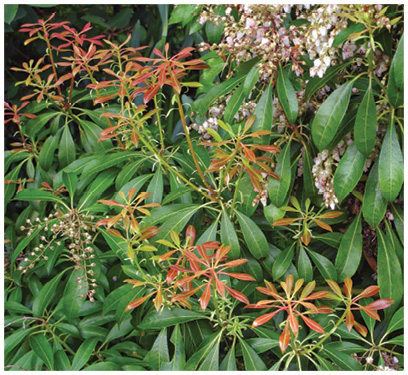
Mountain Fire andromeda (Pieris japonica ‘Mountain Fire’) The evergreen foliage of this shrub shows off bright red new growth in late winter that fades to mahogany and then chestnut tones just as fragrant chains of bell-shaped creamy white blooms appear in abundance in midspring. In summer, leaves turn leathery deep green and black berries form where flower clusters once hung. Prefers partial shade. Grows to 6–8 feet tall and 8–10 feet wide in zones 5–8.
SITE SHADE, PARTIAL SHADE SOIL AVERAGE, MOISTURE-RETENTIVE ZONE 5–8 SEASON SUMMER THROUGH FALL
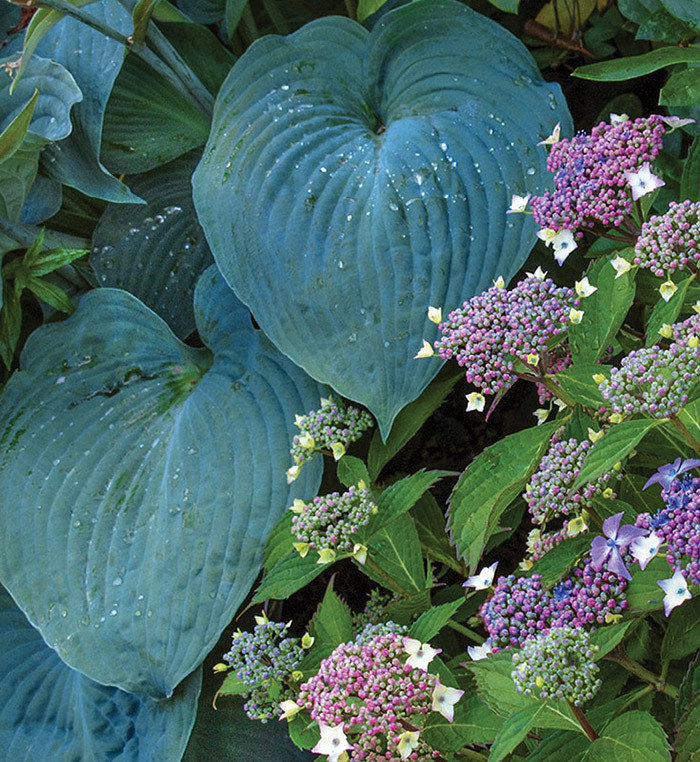
Like the jazzy blues standard recorded in 1953 by Little Walter, “Blues with a Feeling” is the perfect description for this classic hosta-and-hydrangea combo with a rhythm-and-blues twist. The colossal, nearly cerulean blue hosta leaves are the undeniable drumbeat for the looser yet still dazzling harmonica played by the lacecap hydrangea with its wide spectrum of colors. This mix of hues will set just the right tone for sitting back with a New Orleans-style cocktail and listening to the blues.
Early summer warmth encourages the gargantuan blue hosta leaves to spread out in full glory while the hydrangea begins to bud up. As summer gains momentum, the hydrangea blooms begin to show color on the sterile inner flowers as well as the outer petioles. While pale at first, the hue deepens every week to peak in high summer, with soft jewel tones ranging from pink and sapphire to amethyst. Holding these colors for weeks, they begin to fade in autumn to mellow to more classical notes. Fall is the perfect time to add some jazzy white Ice Follies daffodils (Narcissus ‘Ice Follies’) for a long-blooming opening act in spring.
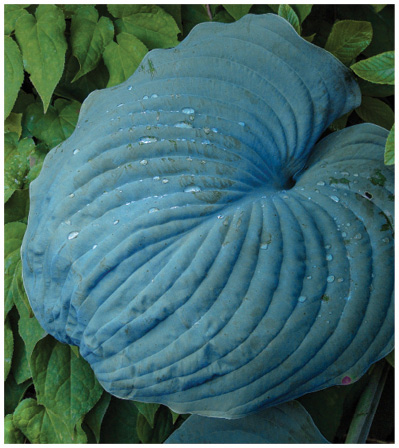
Blue Angel hosta (Hosta ‘Blue Angel’) This blue-green hosta is an attention-getter, with ribbed leaves reaching 16 inches across. Thankfully, it is one of the more slug-resistant varieties, as well as a heavy bloomer from spring to early summer, producing bouquets of white flowers that hummingbirds adore. This unique plant tolerates dry shade, although most prefer consistent moisture. Grows to 3 feet tall and 4 feet wide in zones 3–8.

Pink lacecap hydrangea (Hydrangea macrophylla var. normalis) This is a deceptively hardy large-scale landscape shrub. While the specific cultivar shown here is not known, Blue Wave would work beautifully as an alternative choice to the pink, although the soil pH in your location will affect the final color. Deep and thorough watering at about 1 inch per week will keep it fresh and colorful. Grows to 6 feet tall and wide in zones 5–9.
SITE SHADE, PARTIAL SHADE SOIL WET, MOISTURE-RETENTIVE ZONE 7–8 SEASON SPRING THROUGH FALL

There are great foliage plants and there are great flowering plants. There are also some plants that are both, and in this combination two out of the three ingredients provide the foliage framework and add the finishing touch with a dazzling seasonal floral display. The large brown leaves of Othello leopard plant add drama to the finer blades of the yellow sedge, while the deep golden daisies echo its color. In the background the muted gray-and-cream variegated leaves of a hardy fuchsia bridge the two leaf textures. Pendulous vivid magenta and purple flowers dangle from the fuchsia branches in summer and fall, adding a fresh blast of color and introducing a delicate flower shape to balance the rather disheveled, gaudy daisies. Even without any flowers this trio works well together, but the blooms enhance the combination and are more beautiful because of the backdrop.
Although both the sedge and fuchsia are semi-evergreen, they can look rather tired by spring. To improve winter interest, plant a cluster of prickly heath (Pernettya mucronata) to one side, ideally including one male to every three female plants. These evergreen shrubs have bright winter berries in red, pink, or white. The leopard plant will continue to spread and may eventually need to be divided, while the sedge will just need a quick trim after a hard winter to tidy up the foliage.

Bowles’ golden sedge (Carex elata ‘Aurea’) This short, mounding fountain of semi-evergreen golden blades adds a bright note to shady areas. The grass-like plant needs moist soil and protection from afternoon sun. Grows to 2 feet tall and wide in zones 5–9.
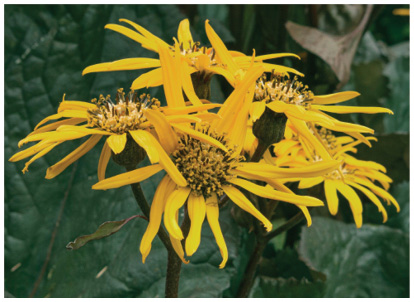
Othello leopard plant (Ligularia dentata ‘Othello’) If you are willing to battle slugs, this perennial is worth fighting for. Large, leathery leaves emerge purple then mature to brown on top with a purple reverse. Golden daisies appear on thick stalks in summer. This plant needs consistently moist soil in a shaded area. Grows to 2–3 feet tall and 2 feet wide in zones 3–8.
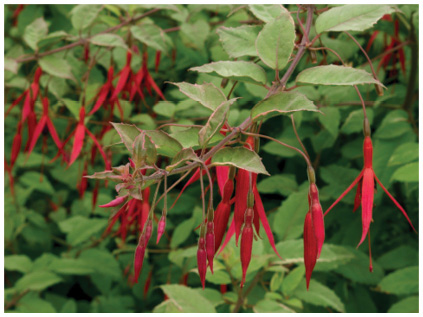
Variegated Magellan fuchsia (Fuchsia magellanica var. gracilis ‘Variegata’) This semi-evergreen arching shrub has attractive variegated foliage in a soft blend of gray-green and cream with pink highlights, veins, and stems. The bright tubular flowers are a favorite of hummingbirds from summer until frost. Ideal conditions are moisture-retentive but not waterlogged soil and morning sun only. In shadier conditions the flower production will be reduced, although the shrub itself will thrive. Do not prune until spring. Grows to 4 feet tall and wide in zones 7–10.
SITE PARTIAL SHADE, PARTIAL SUN SOIL AVERAGE, WELL-DRAINED ZONE 7–10 SEASON SPRING, SUMMER
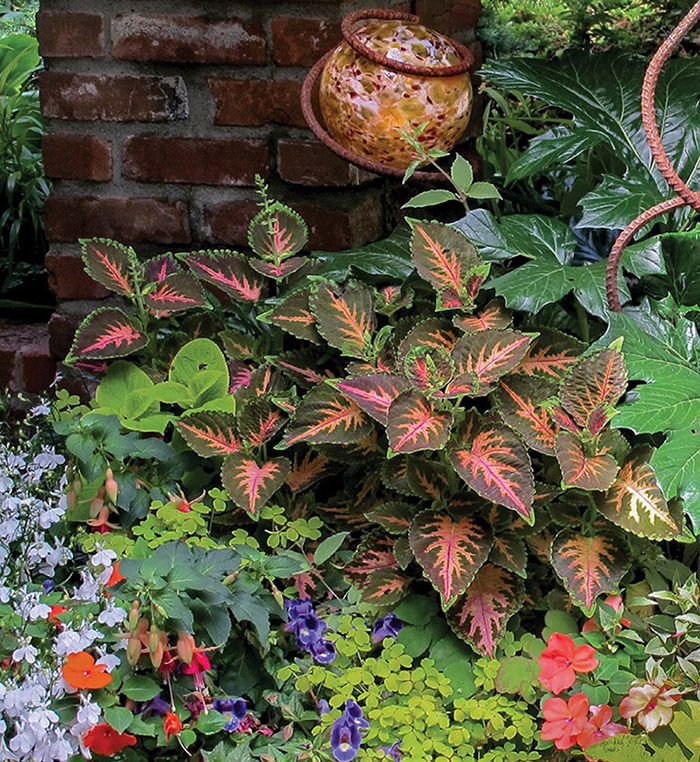
The rich, intense colors of a sunrise and sunset captivate our attention in nature just as they do in the garden. This vibrant and aptly named Coral Sunrise coleus is the showy, focal-point foliage that acts as the inspirational element for the other summer annuals, which add even more sparkle. This combination is mainly about bright hues, but the deep green and glossy foliage of the bear’s breeches offers a quieter spot for the eye to rest while providing a tropical, architectural element with those oversize leaves contrasting with the smaller plants around it. The rusted metal-and-glass garden art is the final element: it plays right into this color scheme and adds a touch of whimsy.
In high summer all these components come together in a zenith of perfection. The coleus has reached a mature size to bud and bloom, the small-flowering annuals are fluffy and full, and the lustrous bear’s breeches are blooming with tall spikes of mauve flowers. This combination will continue to look lively until the truly cold fall weather moves in and the spent annuals are removed for the season. You can also cut back any tired leaves on the bear’s breeches at that time.

Coral Sunrise coleus (Solenostemon scutellarioides Wizard Coral Sunrise) Leaves splashed in shades of coral, lime, and olive with fuchsia veins make this an exciting cultivar to play with in the garden. Pinch off the growing tips occasionally to keep it bushy until late summer, then let it bloom for rich purple flowers. Prefers shade to partial shade. Grows to 14 inches tall and wide. Annual.
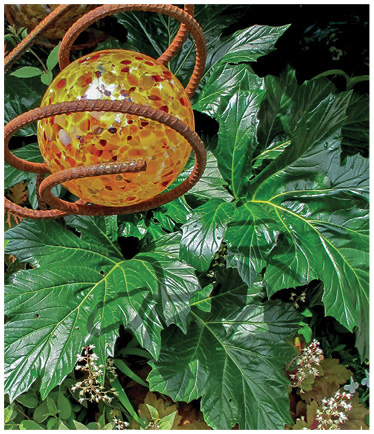
Bear’s breeches (Acanthus mollis) An architectural clump-forming perennial known for its foliage and bold cream-and-mauve flower spikes that can stand up above the leaves as much as 3–5 feet high. The glossy dark green leaves can grow to 2 feet long and may be somewhat evergreen in mild climates. Prefers partial sun to partial shade. Grows to 3–5 feet tall and wide in zones 7–10.
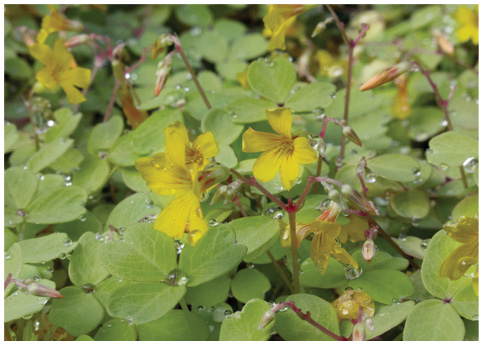
Volcanic shamrock (Oxalis vulcanicola ‘Molten Lava’) A sassy little plant valuable for foliage and dainty yellow flowers in spring and used in summer for the landscape or containers. In shadier conditions the leaves will be more chartreuse, while in sun you can expect gold with rich orange overtones. Prefers full sun to partial shade. Grows to 6–10 inches tall and 1–12 inches wide in zones 9–11 or enjoy as an annual.
SITE SHADE, PARTIAL SUN SOIL AVERAGE ZONE 4–9 SEASON SUMMER
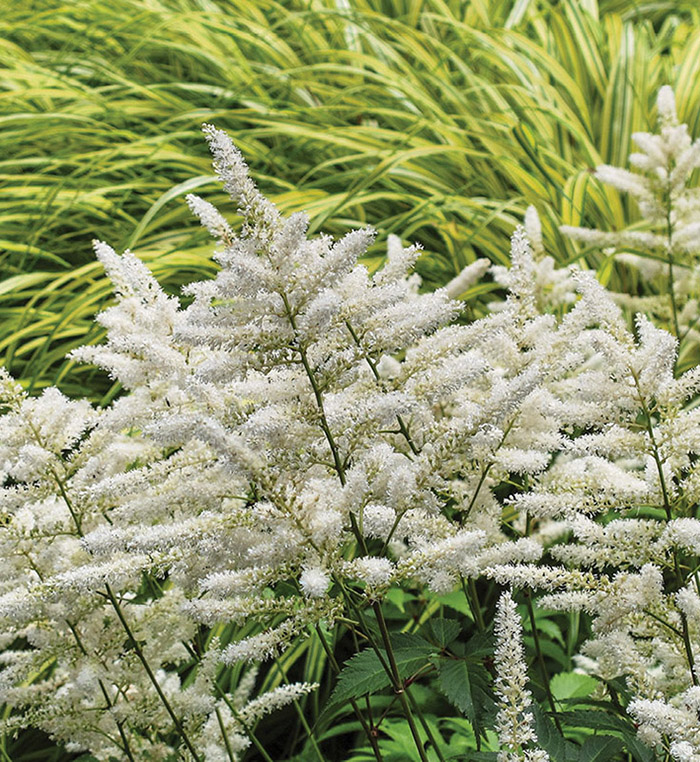
The very idea of dolloping whipped cream on top of an already fabulous dessert full of rich lemon and cream flavors might seem like overkill to some, but others wonder if there is ever really enough of a good thing. Adding the fluffy white astilbe topping to yellow-striped Japanese forest grass is just the thing for those with a sweet tooth. The flowing grass provides exactly the right backdrop to showcase the creamy white vertical flower spikes, giving a perfect contrast in visual texture in this delicately sweet-and-sour mixture.
Summer is when most of us think of tart, pucker-inducing lemon desserts, and it is also the best time for this commingling of flavors. The Japanese forest grass sprouts out and relaxes into its languid flowing form, all laying in one direction. The fern-like astilbe reaches the peak of bloom when we begin to truly get warmth for the growing season in summer. You can almost taste it.

Golden Japanese forest grass (Hakonechloa macra ‘Aureola’) This is a hardy, low-maintenance, shade-loving deciduous perennial grass that arches gracefully into dense, spreading mounds. It is a favorite for its long gold-and-green-striped leaves, which have a bamboo-like texture. Grows to 12–18 inches tall and 2–3 feet wide in zones 4–9.

Visions in White Chinese astilbe (Astilbe chinensis ‘Visions in White’) The ferny bronze-green foliage of this astilbe is striking in contrast with the multitude of large creamy white flower plumes that float above it for weeks at a time. The combination of foliage and blooms is elegant and refined in full sun as well as full shade. Resistant to rabbits and deer. Grows to 2 feet tall and 18 inches wide in zones 4–9.
SITE PARTIAL SHADE, SHADE SOIL AVERAGE, MOISTURE-RETENTIVE ZONE 4–8 SEASON YEAR-ROUND
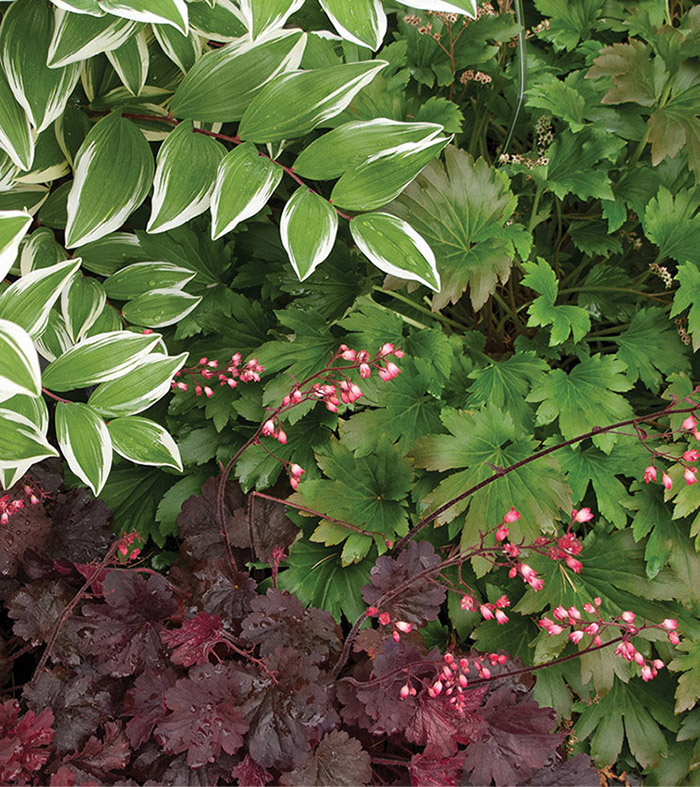
When every plant offers exciting foliage as well as seasonal flowers, you know you have a winning combination. The summer scene shown here highlights the bicolor pink flowers of the coral bells framed by a triad of bold, colorful leaves. Hue is also a linking theme. Those pink tones are echoed by the deep burgundy stems of the richly variegated Solomon’s seal as well as the dark coral bells foliage, while the mukdenia is beginning to take on its summer blush.
In spring the white flowers of both the Solomon’s seal and mukdenia will echo the color of the distinctive creamy white variegated leaves, while the evergreen coral bells add depth. As summer transitions to fall, the mukdenia will turn its namesake crimson while the tall Solomon’s seal introduces shades of translucent gold to the scene. In winter only the coral bells will remain, but adding a cluster of Jacob hellebore (Helleborus niger Gold Collection Jacob) to one side would add sparkle with their large white flowers and fuzzy yellow stamens. The compact Bella Notte coral bells risks being engulfed by the more vigorous Solomon’s Seal and mukdenia, so you may have to thin periodically.
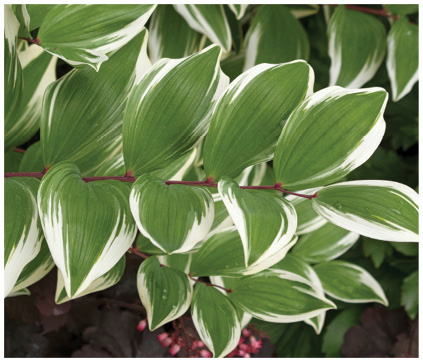
Double Stuff variegated Solomon’s seal (Polygonatum ‘Double Stuff’) The creamy white leaf margins on this variety are twice the usual size, making Double Stuff really stand out in the shade garden. In spring, bell-shaped white flowers dangle beneath the arching red stems. Grows to 2 feet tall and 18 inches wide in zones 3–8.
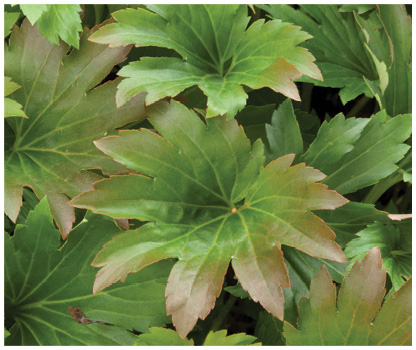
Crimson Fans mukdenia (Mukdenia ‘Crimson Fans’) Green fan-shaped foliage and panicles of white flowers herald spring as this herbaceous ground cover emerges from winter dormancy. As the flowers fade, the foliage takes on red tints that become deeper throughout the summer before turning a brilliant crimson in fall. Grows to 12 inches tall and 2 feet wide in zones 4–9.

Bella Notte coral bells (Heuchera ‘Bella Notte’) This demure coral bells is large enough for the border but will not swallow neighboring plants in a container with overenthusiastic growth. Layers of deep burgundy leaves form a mound. In summer, tall spires of two-tone pink flowers offer a treat for hummingbirds as well as cut flowers for the home. Tolerates heat and humidity. Grows to 9 inches high and 15 inches wide in zones 4–9.
SITE PARTIAL SHADE SOIL POTTING SOIL ZONE 7–9 SEASON SUMMER

Like your favorite frozen summer dessert, this design has tangy flavors of lemon and lime with a sprinkling of bright berries, all served up in a pretty container. This cooling Limelight dracaena and refreshing green-and-white caladium take the sizzle factor out of the shade, while adding just a touch of magenta with a dreamy fuchsia helps to keep things lively. Bold foliage sets off the more delicate flowers in this easy-care combination.
The dracaena is planted for summer indulgence only, but you can take it indoors when temperatures drop in fall and enjoy it as a houseplant. The caladium tuber goes dormant at this time, so you can lift it, allow it to dry, and store it inside for the winter before replanting in spring. In areas where the fuchsia is hardy, you can leave it outside over winter, mulched for protection and pruned to the uppermost buds in spring.
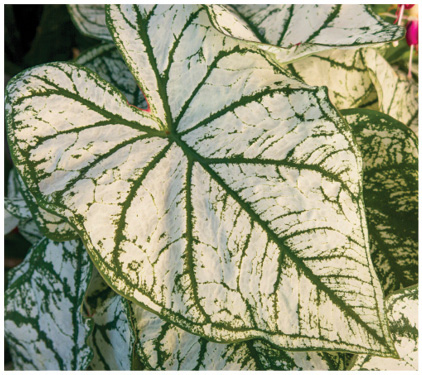
Caladium (Caladium bicolor) Large heart-shaped leaves are paper thin and display beautiful variegation. Cut off older leaves at the base as they fade, and avoid overwatering. Enjoy this plant for summer in filtered morning sun only or in a shaded spot away from direct sun. It makes a beautiful addition to the landscape or containers. Grows to 2 feet tall and wide in zones 10–11 or enjoy as an annual.
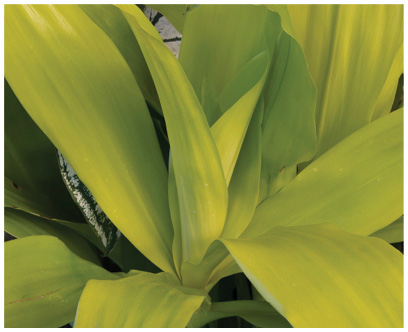
Limelight dracaena (Dracaena deremensis ‘Limelight’) Bold, glossy, strap-like chartreuse foliage makes a bright statement in the shade garden or container for summer. When temperatures begin to dip in autumn, plant this up for the home. Grows to 2 feet tall and wide in zones 10–11 or enjoy as an annual.
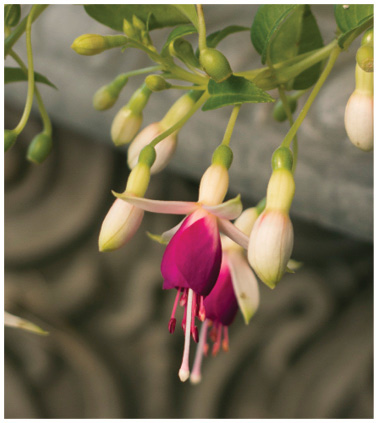
Tom Woods fuchsia (Fuchsia ‘Tom Woods’) This upright-growing fuchsia with creamy sepals and a magenta-purple corolla is a favorite of gardeners and hummingbirds. Protect the crown with mulch in winter. Hardy fuchsias prefer moisture-retentive soil and afternoon shade. Grows to 3 feet tall and wide in zones 7–9; benefits from pruning in spring for shape after danger of further frost has passed.
SITE PARTIAL SHADE SOIL AVERAGE, MOISTURE-RETENTIVE ZONE 3–8 SEASON SPRING THROUGH FALL
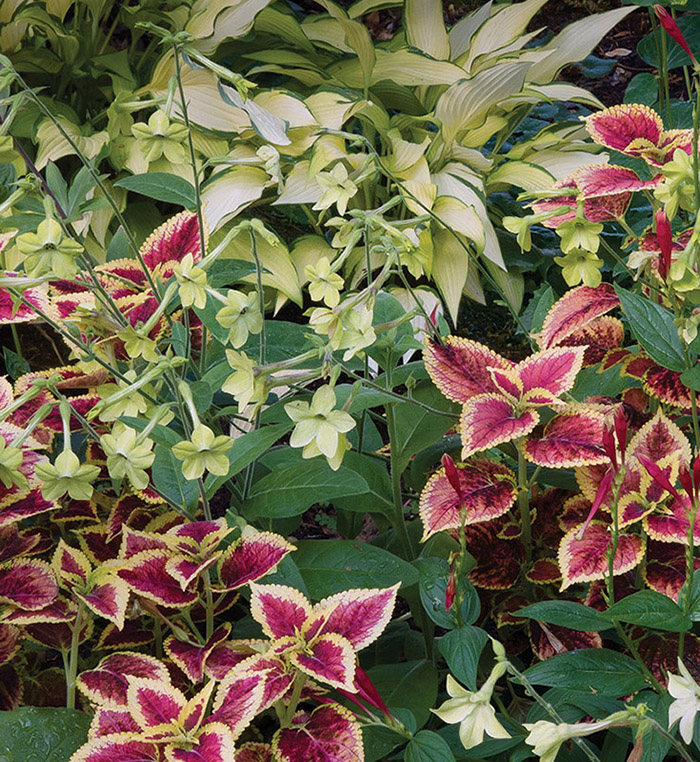
Foliage sets the stage for this summer play. You can rely on the large mounding hosta for changing scenery as it transitions from green to gold during the season. The colorful coleus takes the lead for color and drama, getting stronger with each successive show. The starlet is the delicate Lime Green flowering tobacco plant, which dances across the stage, weaving in and out of her fellow actors with grace. When the season comes to a close, only our memories will remain.
This is a no-apologies summer extravaganza, designed to make the most of the seasonal color offered by the coleus and flowering tobacco plant, which are annuals for many gardeners. During this peak the hosta shows off its bold green-and-gold variegated foliage after maturing from the juvenile green. In fall the perennial hosta will die to the ground and enter dormancy for the winter, leaving the garden bare. Heather Bun white cedar (Chamaecyparis thyoides ‘Heather Bun’) would make an interesting four-season companion. This finely textured conifer forms a 3-foot dome that is green in summer and has a purple cast in winter.
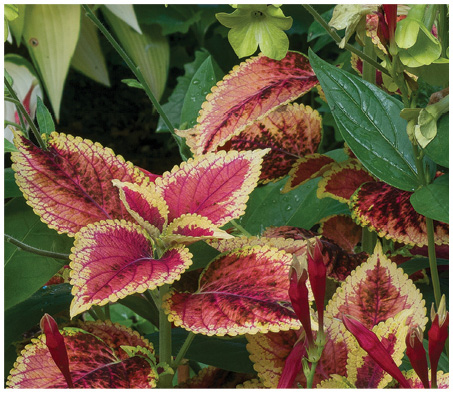
Beckwith’s Gem coleus (Solenostemon scutellarioides ‘Beckwith’s Gem’) Considered an heirloom variety, Beckwith’s Gem is a strong upright coleus with vivid burgundy-and-pink foliage edged with gold. Coleus need moisture-retentive soil, and this variety prefers protection from hot afternoon sun and benefits from occasional trimming through the summer to maintain a bushy habit. Grows to 20 inches tall and 16 inches wide in zones 10–11 or enjoy as an annual.
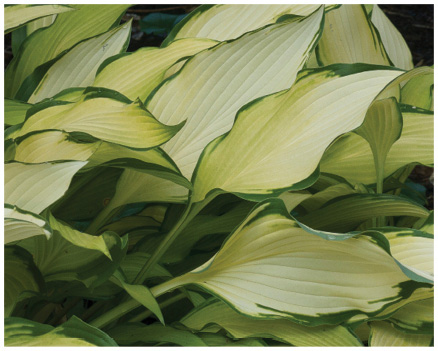
Pineapple Upside Down Cake hosta (Hosta ‘Pineapple Upside Down Cake’) This unusual hosta changes color as it cooks. The long, wavy leaves emerge solid green before the center turns gold to create the variegated look seen here. Hummingbirds are attracted to the 2-foot-tall stalks of lavender flowers in summer. Grows to 18 inches tall and 4 feet wide in zones 3–8.
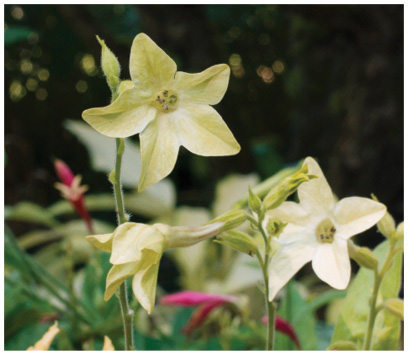
Lime Green flowering tobacco plant (Nicotiana alata ‘Lime Green’) Bushy plants seem to glow with a profusion of star-shaped chartreuse flowers that slowly fade to a creamy lime. Tobacco plants are deer resistant, make great cut flowers, and attract hummingbirds and butterflies. Prefers rich soil and full sun or partial shade. Grows to 3 feet tall and 2 feet wide in zones 8–10 or enjoy as an annual.
SITE: PARTIAL SHADE, PARTIAL SUN SOIL AVERAGE ZONE 4–9 SEASON YEAR-ROUND
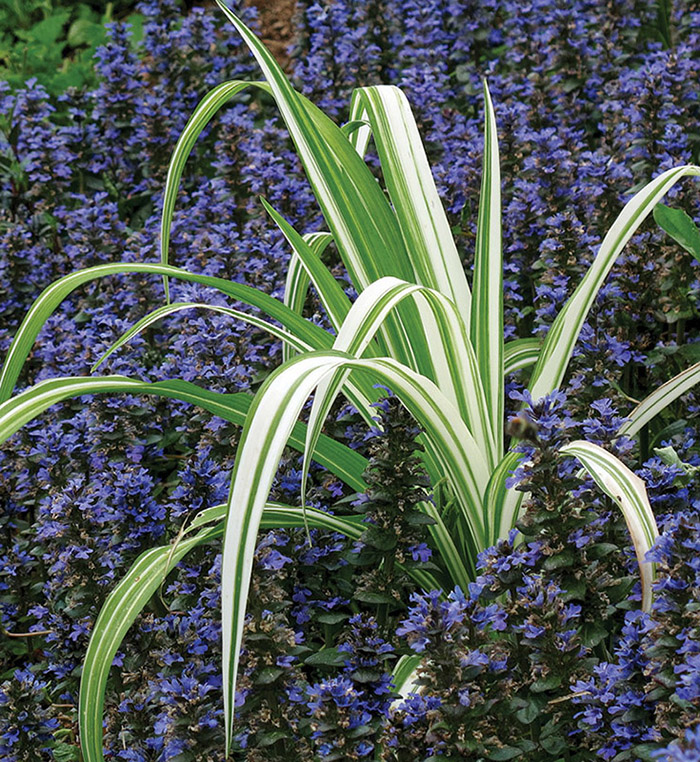
In the 1960s, high fashion went into a distinctly modern mode of simple color-blocked patterns and shapes. Bold and high-contrast pairings like black and white were the order of the day. This combination is reminiscent of that vivid idea with a simple yet in-your-face carpet of violet blooms on the dramatic black bugleweed foliage. The white variegated daylily brings a vivacious and graphic element with white-and-green stripes that stand out as a horticultural fashion-forward element.
This high-impact mix is most impressive in spring, when the electric violet blooms of bugleweed are charged up with color. This border will still look fabulous when the bugleweed ground cover is not blooming, as it still has semi-evergreen rich black leaves set against the unique daylily foliage. In late summer, this expressive daylily blooms with a bold double orange flower to continue the stylish theme. A wonderfully attractive substitute for the bugleweed is variegated Japanese spurge (Pachysandra terminalis ‘Silver Edge’). The two white variegated plants together would be classy and chic.

Variegated double-flowering daylily (Hemerocallis fulva ‘Kwanso Variegata’) This daylily shows off unique white-and-green variegated foliage and a lovely orange double flower blooming in August. This plant is not fussy: as long as it gets at least partial to full sun and average soil, you will not have much else to worry about, except the occasional solid green offshoot that you dig out to keep the beautiful variegation strong. Grows to 2–3½ feet tall and wide in zones 3–9.

Black Scallop bugleweed (Ajuga reptans ‘Black Scallop’) What do you get when you add black-purple foliage with scalloped edges and dark violet flowers on a matte-forming perennial? A hardy, prolific ground cover that provides a natural weed barrier in sun to partial shade that is striking to look at. Grows to 4–6 inches tall and 12–18 inches wide in zones 4–9 even in heavy, wet soils.
SITE PARTIAL SHADE, SHADE SOIL POTTING SOIL OR AVERAGE, MOISTURE-RETENTIVE ZONE ANNUALS SEASON SUMMER
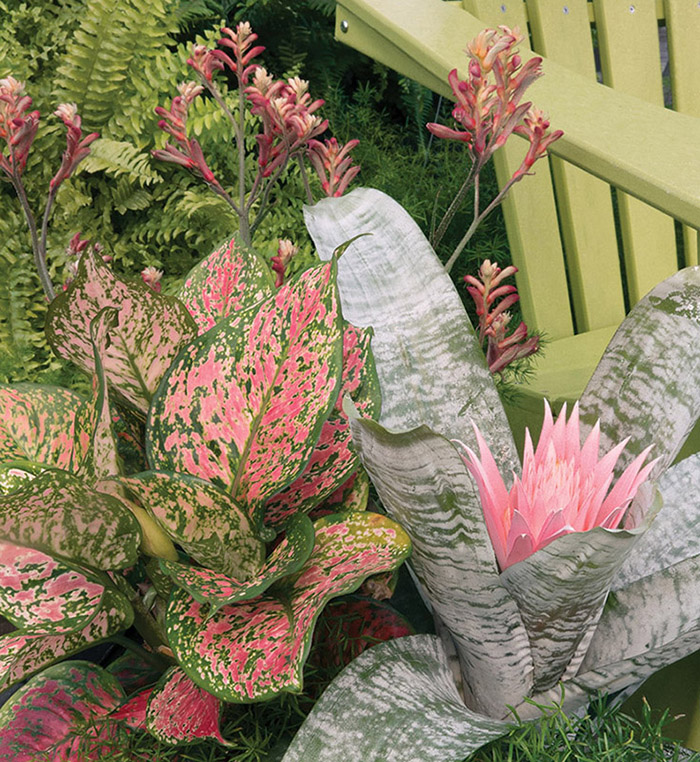
You can pot up this versatile design as a large container combination, site into a shady corner of the garden, or plant as a mixture to make seasonal switch-outs a breeze and allow for the kangaroo paws, which prefer more sun. Pink is the color scheme here, established by the mottled foliage of the Chinese evergreen and highlighted by the exotic urn plant flower and kangaroo paws. Tempering all the sugary sweetness is the acid-green Boston fern, whose fronds also introduce softer, finer textures. This vignette will have you tickled pink all summer.
Be ready for a summer party at a moment’s notice and keep a colorful pot of sun-loving kangaroo paws ready to tuck into a shade arrangement for an instant makeover, returning it to a sunnier spot the following day. The remaining plants can stay in the shade garden for the entire summer, where the lush and colorful foliage will provide a low-maintenance display. Come fall, you can bring all of these indoors or simply treat them as annuals.

Lady Valentine Chinese evergreen (Aglaonema ‘Lady Valentine’) A slow-growing tropical houseplant that all gardeners can enjoy outside during the warm summer months. Beautiful speckled foliage in salmon pink and green with distinct green veins make this an eye-catching addition to the shade garden or container. Grows up to 2 feet tall and wide in zones 10–11 or enjoy as an annual.
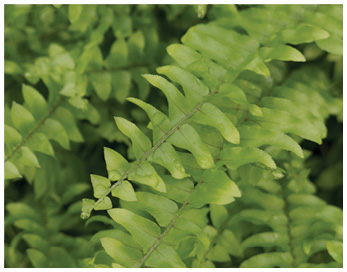
Boston fern (Nephrolepis species) Perhaps the most well known and widely used tropical fern, this is noted for its rich green fronds with almost flat, graceful leaflets. They make lush houseplants, or when temperatures are mild you can enjoy them outside in hanging baskets, on pedestals, in pots, or planted into the landscape. They prefer a rich, moisture-retentive soil and high humidity in full shade to partial sun. Grows to 3 feet tall and wide in zones 10–11 or enjoy as an annual.
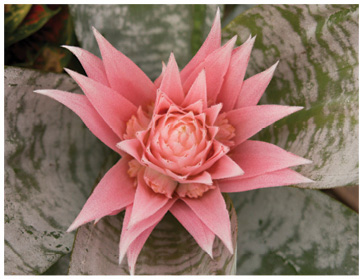
Urn plant (Aechmea fasciata) A bromeliad with arching, leathery leaves that overlap into a rosette, forming a watertight vase or urn that gives rise to its common name. From the center of this vase rises a stalk with its unique spiky pink bloom that can last for several months. Pour water directly into the vase and keep the surrounding soil moist but not wet. You can set this popular houseplant outside in the shade for the summer when temperatures are 70°F or hotter. Grows to 18 inches tall and wide. Annual.

Kangaroo paws (Anigozanthos species) Exploding from a grass-like clump of basal foliage, wiry stalks of fuzzy flowers in iridescent colors make a fine summer display. The size of the plant will vary with cultivar, but all grow best in full sun and well-drained soil, thriving both in the landscape and container gardens. Grows to 1–20 feet tall and 1–3 feet wide, depending on cultivar, in zones 9–11 or enjoy as an annual, then overwinter indoors.
SITE PARTIAL SHADE SOIL POTTING SOIL ZONE 7–9 SEASON SPRING THROUGH FALL
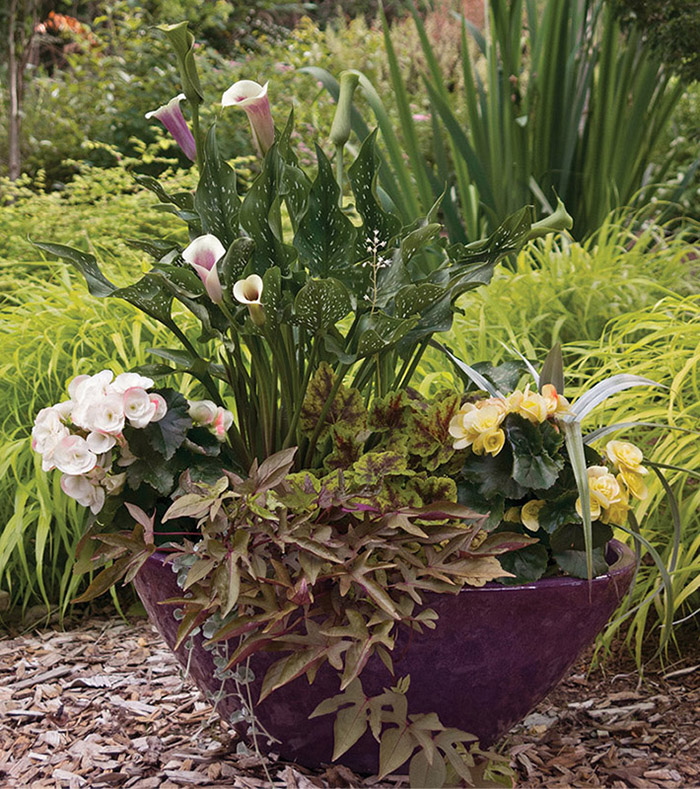
This artistic design offers plenty of flowers but relies on a framework of five-star foliage plants to really make it shine. Attention to detail is evident from the tight color echoes between the purple pot, calla lily, and hosta foliage, while metallic silver accents play off the white flowers and golden leaves connect with yellow blooms. Rather than creating a predictable symmetrical arrangement, try placing the calla to one side and balancing it with the astelia. This adds a sophisticated touch, as does layering one trailing plant over another. Dare to be different.
This design is intended to be taken apart in fall after providing five months of exciting color from both foliage and flowers. Although there are a lot of plants in this pot, they are carefully placed so they do not impede one another. The astelia will easily grow through the loose coral bells foliage and the dichondra will hug the sides of the pot, while the sweet potato vine has a more relaxed trailing habit. The only maintenance required is periodically removing spent flowers and trimming trailing plants when they get too long.
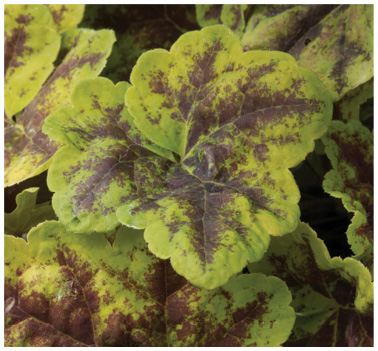
Leapfrog foamy bells (Heucherella ‘Leapfrog’) Vivid yellow foliage softens to light green as it matures, and each scalloped leaf has deep purple markings. In late spring hummingbirds are attracted to the ivory flowers that appear on tall spikes. Leapfrog makes a tidy mound and tolerates heat and humidity. It does best with morning sun only. Grows to 12 inches tall and wide in zones 4–9.
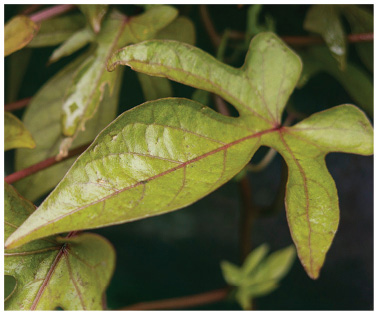
Sweet Caroline Bronze sweet potato vine (Ipomoea batatas ‘Sweet Caroline Bronze’) Attractive maple-type bronze leaves are purple on the reverse. Plant this annual vine as a ground cover in the landscape or allow it to trail from a container. Grows to just 8 inches high but can trail 5 feet long, so you will need to trim it in shorter pots. Annual.
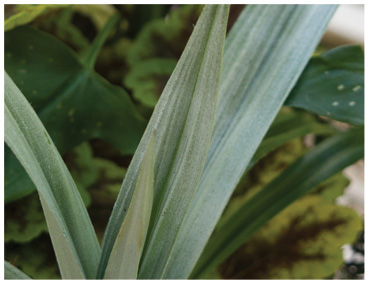
Silver Shadow astelia (Astelia ‘Silver Shadow’) Bold metallic silver leaves make this evergreen perennial stand out from the crowd. Use in drought-tolerant landscape designs or container plantings. Grows to 2–3 feet tall and 2–4 feet wide in zones 7b–11 or enjoy as an annual before bringing indoors for the winter.
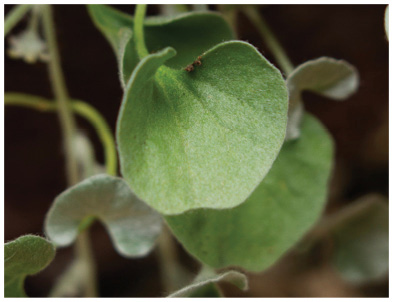
Silver Falls dichondra (Dichondra argentea ‘Silver Falls’) Metallic silver leaves are the hallmark of this popular plant. An evergreen perennial ground cover in warm climates, it is noted for its drought tolerance. However, all gardeners can enjoy it as a trailing container plant, where it will add sparkle to designs in full sun or partial shade. Grows to 2–6 inches tall and 2 feet wide in zones 9–11 or enjoy as an annual.

Picasso calla lily (Zantedeschia ‘Picasso’) Even if this never bloomed it would be a beautiful plant for the silver spotted foliage alone. However, the trumpet-shaped creamy white flowers with deep purple throats are truly lovely and appear over many weeks. This dwarf calla lily does not require staking like its larger cousins. Grows to just 2 feet tall and 12 inches wide in zones 9–10 (8 with winter protection) or enjoy as an annual.
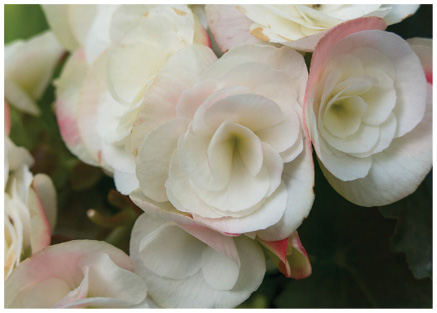
Amstel Clara Rieger begonia (Begonia xhiemalis ‘Amstel Clara’) Double white flowers suffused with pink appear all summer, set off by the succulent green foliage. This begonia takes more sun than most but does best with afternoon protection. It has an upright mounding habit. Grows to 12–18 inches in zones 9–11 or enjoy as an annual.
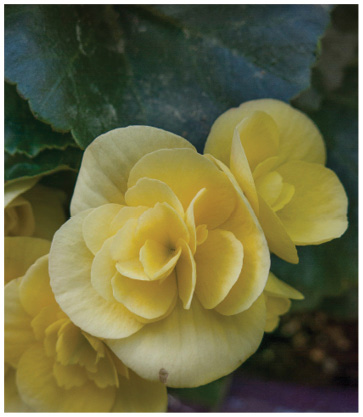
Amstel Blitz Rieger begonia (Begonia xhiemalis ‘Amstel Blitz’) Double yellow flowers and succulent green leaves keep this looking fresh through the summer heat. Grows to 12–18 inches in zones 9–11 or enjoy as an annual.
SITE PARTIAL SHADE, SHADE SOIL POTTING SOIL ZONE 7–9 SEASON YEAR-ROUND

What do you get when you combine bold tropical leaves with woodland perennials in a simple clay pot? A design that is unexpected yet works. The glossy variegated leaves of the tropical-esque fatshedera add height to the design, while the earth tones of the foamy bells pick up on the warm sunset shades that the rustic pot suggests. Dark foliage of purple heart and begonia highlights the rich purple veins of Sweet Tea foamy bells, while the finely textured golden sedge softens the overall composition and adds light. Exploding like tiny orange sparks, the begonia flowers are the perfect finale to this scene.
To keep this design looking its best, you may have to prune the fatshedera and purple heart occasionally to keep them shorter and bushier, balancing the overall proportions. All but the purple heart and begonia are evergreen, so this combination has the potential to remain in the rustic container for some time. However, the pot is not large, so as the fatshedera grows it will become root bound and may need transplanting after the first season. The foamy bells and sedge could certainly remain for many years, and you could also introduce new shade-loving companions, such as the dark-leaved Maroon Beauty strawberry begonia (Saxifraga stolonifera ‘Maroon Beauty’).
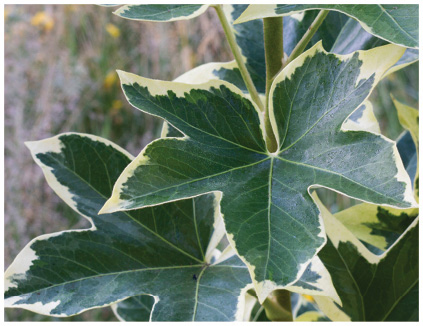
Angyo Star fatshedera (xFatshedera lizei ‘Angyo Star’) A hybrid between Japanese aralia and English ivy, this evergreen shrub offers the best of both without the problems. The glossy ivy-shaped leaves have a clean creamy variegation that lights up shady areas. Unlike ivy, this does not climb, so you will have to stake the main stem as it grows taller. You can enjoy this versatile shrub as a houseplant, but it is also hardy outdoors in zones 7b–9, where it will grow to 5 feet tall and 18 inches wide.
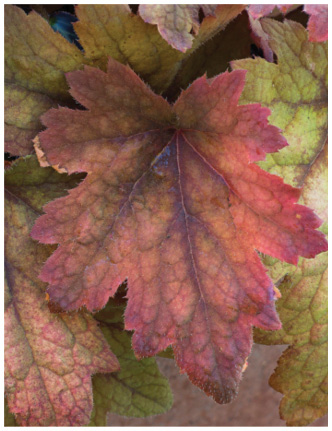
Sweet Tea foamy bells (Heucherella ‘Sweet Tea’) One of the best foamy bells for shade containers, Sweet Tea forms a bold mound of sunset-colored foliage, each leaf with burgundy veining. Spring tones are typically brighter orange and coral, maturing to deep cinnamon by fall. Spires of creamy white flowers appear throughout the spring and summer. Grows to 20 inches tall and 28 inches wide in zones 4–9.

EverColor Everillo golden sedge (Carex oshimensis EverColor ‘Everillo’) An easy-care evergreen grass for the shade garden and containers, this becomes a loose mounding fountain of gold. Trim away damaged blades after the winter for a tidier appearance. Grows to 20 inches tall and 28 inches wide in zones 5–11.
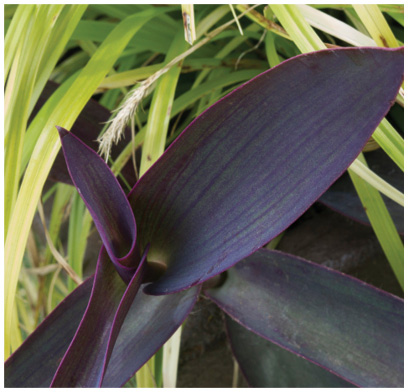
Purple heart (Setcreasea pallida ‘Purple Heart’) This trailing tender perennial is grown as a ground cover in temperate areas, enjoyed as an indoor plant, or planted as a summer annual in sun or shade containers, where it will meander and trail through companions. Grown primarily for its purple foliage, it also blooms with small lavender flowers. Grows to 12–18 inches tall and 16 inches wide in zones 8–11 or enjoy an annual.

Sparks Will Fly begonia (Begonia ‘Sparks Will Fly’) Single orange blooms fade to yellow, packing a serious color punch in the shade garden, but the dark bronze-black leaves really set this begonia apart from the competition. This annual will spill slightly over the edge of containers, but it is not a long trailer and is ideal for shorter pots. Grows to 12 inches tall and wide.
SITE PARTIAL SHADE, PARTIAL SUN SOIL AVERAGE ZONE 4–8 SEASON YEAR-ROUND
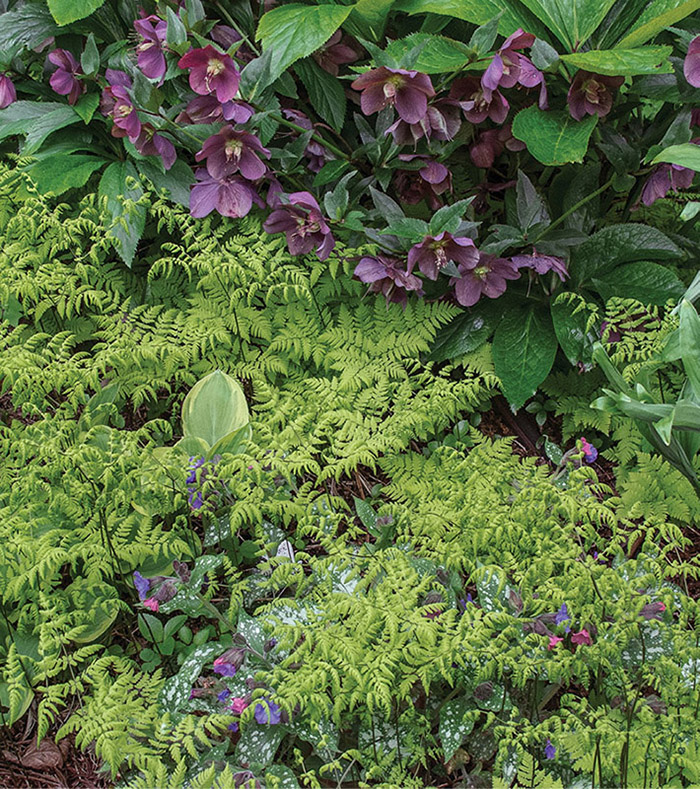
This combination is well suited for up-close viewing, such as near a path or a low wall where onlookers can appreciate the fine details. The lacy green foliage of the Pacific oakfern weaves easily through the lower tiers of this woodland garden, its soft texture contrasting with the coarse lungwort leaves and the leathery foliage of the Lenten rose. The speckled silver leaves of the lungwort were introduced to break up the carpet of green, and the resulting combination forms a perfect backdrop for the spring flowers in shades of dusky pink, blue, and purple.
The deep plum flowers on the Lenten rose are one of the earliest to appear in spring, and they last for weeks before fading to a soft, muted mauve as the interesting seed heads mature. When the flowering stems are cut back in late spring, this bushy plant will push out new evergreen foliage that holds up beautifully through the year, although you may want to tidy tattered winter leaves just before the new flowers erupt in late winter. Blooms on the lungwort emerge pink and mature to blue, creating a lovely contrast when mixed with the larger flowers on the Lenten rose. The lungwort’s interesting foliage remains attractive until fall. The fern’s intense green color will stay vibrant through most of the season but can get stressed in excessive heat, so you may need to cut it back in late summer.

Pacific oakfern (Gymnocarpium disjunctum) This charming perennial makes a wonderfully tough ground cover in a garden where it will receive partial to full shade. Creating a bright understory for the larger plants above, this deciduous fern mixes and weaves its lacy foliage with other low-growing shade plants. Trim any distressed foliage in late summer. Grows to 9–15 inches tall and wide in zones 2–8.
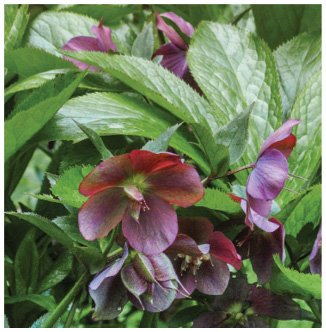
Lenten rose (Helleborus xhybridus ‘Blue Lady’) Preferring partial to full shade, this bushy evergreen is a clump-forming perennial. Noted for its glossy, leathery dark green leaves and cup-shaped plum flowers, which bloom at the tips of leafy stems from late winter to midspring. Cut back any tired foliage after winter to reveal the early flowers. Grows to 12–18 inches tall and wide in zones 4–9.
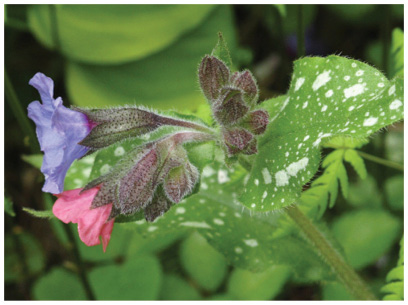
Lungwort (Pulmonaria) This unique woodland perennial, which grows in a low clump, is named for the leaves’ resemblance to diseased lungs. Bell-shaped flowers that change from pink to blue enhance the display over the long bloom period on splotched, speckled, fuzzy foliage. This adaptable plant can grow in light that ranges from sun to shade depending on the variety and level of soil moisture. Although the name of this particular variety is not known, Mrs. Moon would give a similar look. Grows to 6–12 inches tall and 18 inches wide in zones 3–8.
SITE SHADE, PARTIAL SHADE SOIL AVERAGE, MOIST ZONE 7–8 SEASON SPRING THROUGH FALL
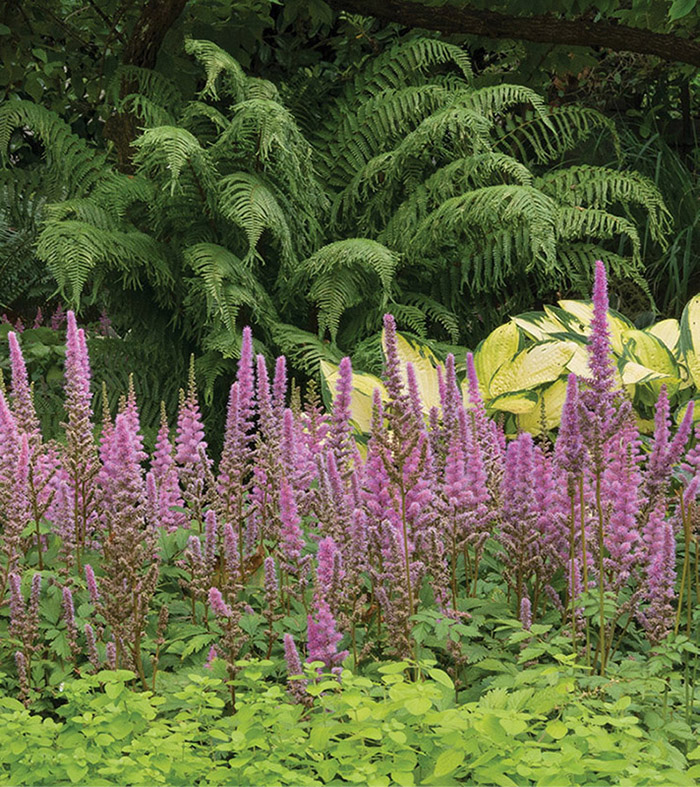
As timeless as the classic twin set of a coordinating sweater and cardigan, this combination has the perfect balance of repetition and uniqueness. Bold hosta leaves separate feathery ferns and fern-like astilbe, while golden oregano and hosta avoid color collision thanks to the ribbon of medium green astilbe foliage that separates them. Adding that finishing touch is a necklace of fluffy pink astilbe flowers that are as pretty when fresh in summer as they are dried in fall.
Early spring sees the slow unfurling of fern fronds behind the bold hosta leaves, which emerge bright chartreuse. The coarse astilbe leaves and softer oregano also add early spring interest. As the season progresses, the hosta leaves turn golden yellow, eventually fading to white, while the fluffy pink flowers of the astilbe introduce a new color in midsummer. All the perennials are herbaceous, so by August this three-season composition will start to fade. The plants will continue to spread, so you may need to divide and thin occasionally to maintain the layered effect. This would be a delightful setting for a mass planting of ephemeral spring bulbs like the dog tooth violet (Erythronium ‘Pagoda’), whose fringed elfin-cap yellow flowers would suit this woodland setting perfectly.

Gold Standard hosta (Hosta ‘Gold Standard’) With hand-size (or larger) leaves, this large hosta knows how to make a statement. The golden yellow leaves have an irregular dark green margin with a seersucker-type texture that holds the morning dew like shining jewels. Late summer produces tall spikes of lavender flowers, which hummingbirds favor. Be sure to bait for slugs. Grows to 3 feet tall and wide in zones 3–8.
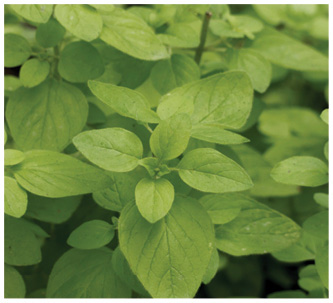
Golden oregano (Origanum vulgare ‘Aureum’) Although edible, this variety has little flavor and is primarily grown as an ornamental ground cover. The attractive foliage emerges chartreuse before maturing to a softer green. Unlike most herbs, golden oregano needs partial shade rather than full sun. Grows to 12 inches tall and 2 feet wide in zones 7–9, evergreen in milder climates.
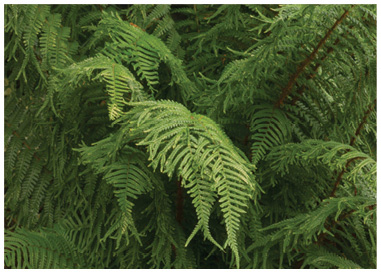
Golden male fern (Dryopteris affinis (Polydactyla Group) ‘Polydactyla Dadds’) This easy-care Victorian fern for the shade garden is resistant to deer and rabbits. It is semi-evergreen but benefits from older fronds being cut down in spring. Grows to 3 feet tall and wide in zones 4–8.
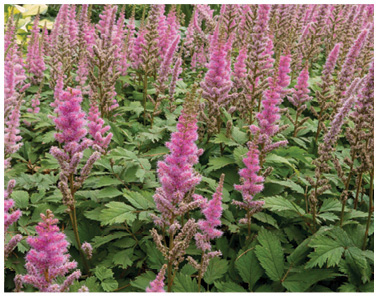
Visions in Pink Chinese astilbe (Astilbe chinensis ‘Visions in Pink’) Plumes of light pink flowers on this herbaceous perennial accent the blue-green fern-like foliage in summer. Shorter than other species, Visions in Pink is a dense upright form that does not require staking and also tolerates drier soils. Grows to 20–24 inches tall and wide in zones 3–8.
SITE SHADE, PARTIAL SHADE SOIL AVERAGE, MOISTURE-RETENTIVE ZONE 3–8 SEASON SPRING, SUMMER

A woodland garden is a true test of just how tough a plant can be when it has to compete with larger trees and shrubs casting shade and taking up precious room that little roots need to survive. This combination proves that delicate-looking plants can also be resilient. The maidenhair fern fills out along the border in a cool, refreshing river of light green lacy texture that bubbles and froths, allowing the wild sweet William to rise up and bloom in an abundant spring gush of airy lavender blooms and fragrance.
This duo of tenacious perennials peaks in spring, when the five-petaled pale blue wild sweet William is in full glory. When the flowers are done blooming, consider adding an oakleaf hydrangea as a hardy flowering shrub to continue the show for summer. The underlayer of luxurious ferns contrasts with the hydrangea’s bold oak leaf-shaped foliage, while fabulously long-lasting blooms and elegant burgundy fall color will carry this woodland mix late into the year with durable elegance.
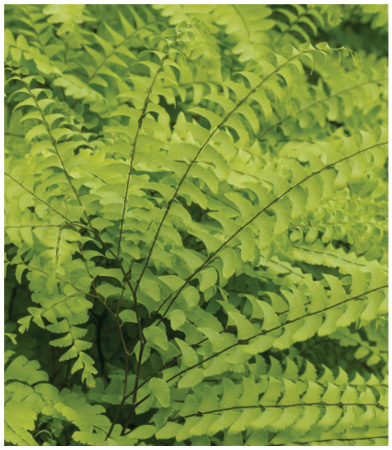
Northern maidenhair fern (Adiantum pedatum) This herbaceous fern is valued for growing densely in moist, heavy shade conditions, as well as for the airy texture that contrasts so well against broad-leaved plants such as hosta and Siberian bugloss (Brunnera macrophylla). In sites where other plants struggle, such as steep slopes, this creeping fern thrives. If you look closely, the plant has a lot of character, with wiry black stems and sometimes a slight curve to the frond. Grows to 12–18 inches tall in zones 3–8; it will colonize over time, so give it room.
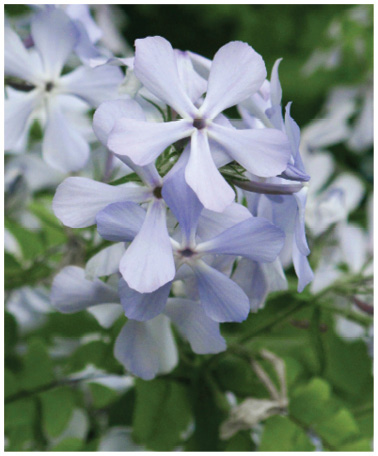
Wild sweet William (Phlox divaricata) This plant has it all. The flowering woodland perennial’s deer resistance, fragrance, star-shaped lavender blooms, and shade tolerance will not disappoint—and hummingbirds and butterflies love it. It is low growing and has the flexibility to be at home in rock gardens, crawl like a ground cover, or work well in naturalized gardens. Grows to 12–15 inches tall and 1–3 feet wide in zones 3–8.
SITE SUN, PARTIAL SUN SOIL POTTING SOIL ZONE 4–9 SEASON YEAR-ROUND
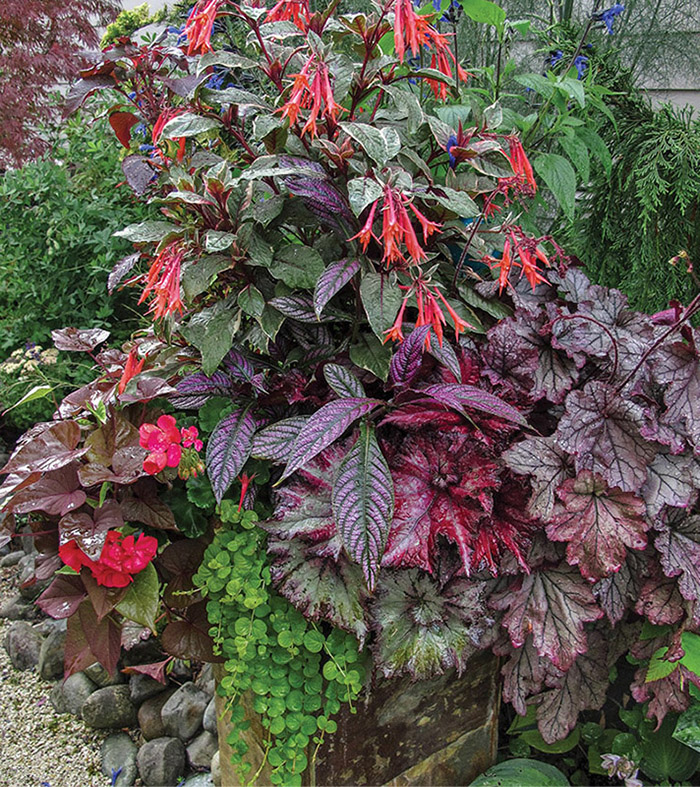
This intensely hued and abundantly layered container design is overflowing with ornate foliage patterns that convey the feeling of a baroque tapestry. The rich tones of leaves and blooms weave together subtle and elaborate brocade qualities. The clusters of fuchsia flowers sparkle against unusual creamy variegated leaves that give light to the more deeply toned patterns of the other plants. Yellow-green creeping Jenny vine cascades from underneath the lavish begonia foliage to light up the robust darker colors and textures.
This container has personality that changes with each passing week from spring through fall, but in high summer it hits its max of rich tones and textures from foliage to flower. The coral bells begins to bloom in spring with white flower wands, quickly joined by summer annuals and the fuchsia for bloom power through fall. For most gardeners this will essentially be a summer container, as all but the coral bells are removed at the end of fall.
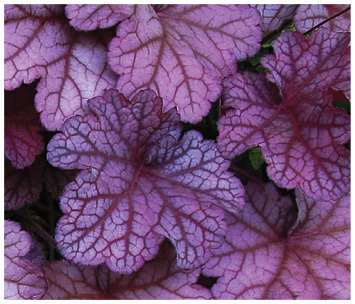
Berry Smoothie coral bells (Heuchera ‘Berry Smoothie’) A year-round winner, this evergreen perennial glows with magenta shades in spring, deepening as the season progresses. The adaptable cultivar will take full sun to full shade, providing the soil does not dry out, and is known for its ability to tolerate heat and humidity. Grows to 18 inches tall and wide in zones 4–9.

Rex begonia (Begonia rex) Rex begonia is a fabulous foliage plant for the home or summer garden with many cultivars available, each with unique markings. Use in the shade garden with finely textured ferns or at the edge of a shady container. Each plant forms a tight clump. Be careful not to overwater. Grows to 12 inches tall and wide. Annual.
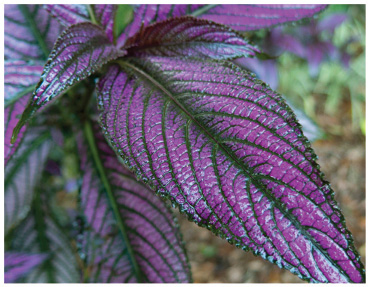
Persian shield (Strobilanthes dyerianus) With its iridescent foliage in shades of purple, green, and silver, this plant is unusual and eye catching. Let it weave in and out of its neighbors for unexpected combinations. Grows to 3 feet tall and 2 feet wide in zones 9–10 or enjoy as an annual.
Firecracker fuchsia (Fuchsia triphylla ‘Firecracker’) Clusters of long, tubular orange flowers with pink-orange interiors dangle from the arching branches of this heat-tolerant shrub, while the green-and-cream variegated leaves have glowing rosy veins and undersides. This tender woody perennial prefers sun to partial shade. Grows to 2–3 feet tall and wide in zones 10–11 or enjoy as an annual.

SITE PARTIAL SHADE, SHADE SOIL AVERAGE, MOISTURE-RETENTIVE ZONE 7 SEASON YEAR-ROUND

Bring a tropical look to a temperate garden with these attention-grabbing plants. A big-leaf magnolia forms an overhead canopy, while mountain bamboo acts as a screen to separate this mini-jungle from the sunny garden beyond. Within this dappled enclave, both the moisture-loving darmera and Rodger’s flower can reach their full steroidal potential, reminiscent of an ancient forest where dinosaurs might roam. The layering effect of the three bold-leaved plants allows each to have its own distinct space, while the finer-textured leaves of the bamboo add contrast.
The excitement starts to build in spring, as the darmera pushes forth its naked, prehistoric-looking flower stalks. Shortly afterward the rich brown new growth of the Rodger’s flower emerges and the dinner plate-size magnolia blossoms open and release their scent. As that spectacle fades, the airy plumes of the Rodger’s flower appear, now backed by the bold darmera leaves. In winter only the bamboo foliage remains, and dark green culms provide structure.
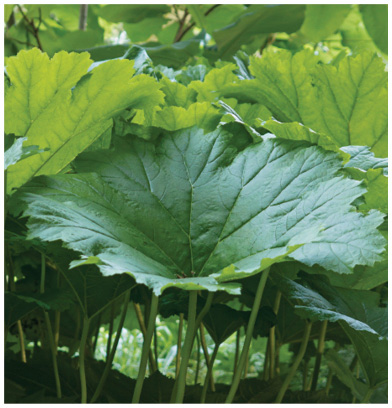
Darmera (Darmera peltata) A vigorous herbaceous perennial that needs plenty of room to spread. This shade lover will tolerate more sun if planted in wet soils. Pink and white flowers appear in spring before the leaves. Grows to 3–6 feet tall and 5 feet wide in zones 5–7.
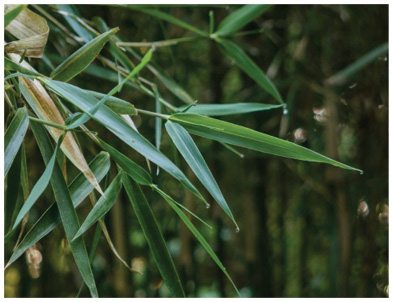
Mountain bamboo (Thamnocalamus tessellatus) One of the best clumping bamboos for full sun, this has a strong upright growth habit but does not do well in hot, humid climates. Grows 16 feet tall in zones 7–10; plant within a rhizome barrier to control spread.
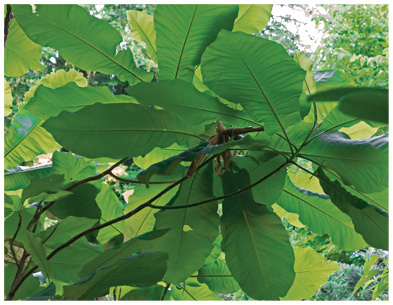
Big leaf magnolia (Magnolia macrophylla) With leaves that grow up to 3 feet long, this deciduous magnolia will not go unnoticed. In early summer fragrant white blooms appear, each up to 12 inches in diameter, followed by a cone-shaped pod containing large red or scarlet seeds. Prefers moisture-retentive soil in full sun to partial shade. Grows to 40 feet tall and wide in zones 5–9.

Red-leaf Rodger’s flower (Rodgersia podophylla ‘Rotlaub’) The large jagged foliage of this herbaceous perennial opens bronze and matures to green with overtones of deep red and copper. The heavily textured leaves form a mounding dome, above which plumes of airy white flowers appear in summer. To look its best, this plant needs wet soil and full to partial shade. Grows to 3–4 feet tall and wide in zones 5–9.
SITE PARTIAL SHADE SOIL AVERAGE, WELL-DRAINED ZONE 6–7 SEASON YEAR-ROUND
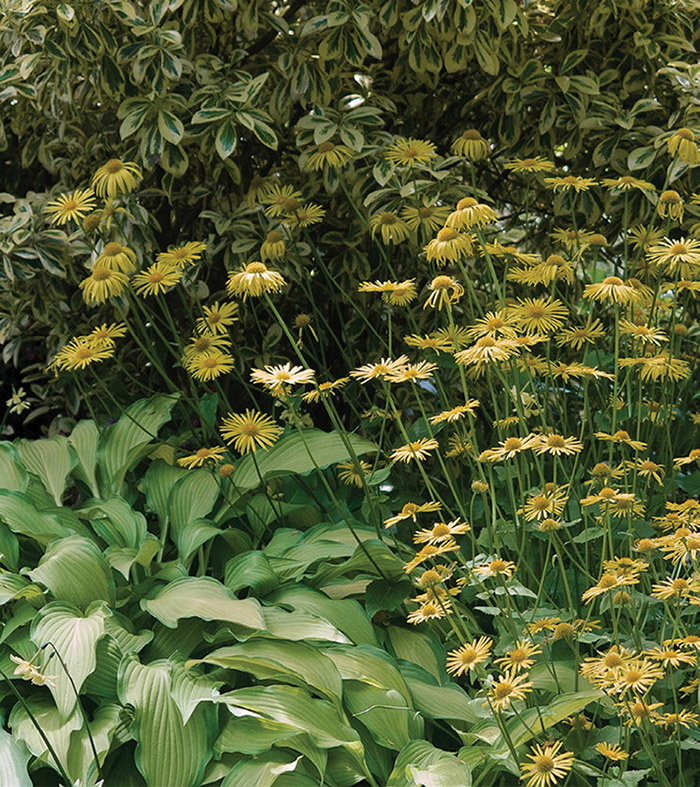
Juicy layers of foliage create a sunny monochromatic framework for the golden daisies. While the Pineapple Upside Down Cake hosta forms a smooth filling against which the flowers can lean, the tall variegated euonymus provides a bold backdrop. The result is a perfect balance between foliage and flowers, yet the hosta is ready to crush and disguise the dormant leaves of the leopard’s bane when needed.
The story does not end when this trio is at its peak in spring. As temperatures rise, the leopard’s bane will become dormant. The hosta foliage, which will be a wide mound of wavy brilliant yellow, will quickly fill the space. Meanwhile, the evergreen variegated foliage of the euonymus will add height and color even after the hosta dies back in fall. The only necessary maintenance is pruning back the euonymus occasionally to prevent it from crowding the perennials. For additional winter interest, a dwarf mugo pine (Pinus mugo ‘Pumilio’, also sold as P. Mugo var. pumilio) would repeat the mounding shape of the hosta, while the spiky texture of the needles would introduce a finer texture.

Silver Queen euonymus (Euonymus japonicus ‘Silver Queen’, also sold as Euonymus fortunei ‘Silver Queen’) A true workhorse in the garden, this evergreen shrub will tolerate poor soils. You can trim it as a hedge or leave it to grow into its natural upright form. The attractive glossy leaves have a bold white margin, making it an ideal candidate to show off darker colors or add a highlight to a mixed border. Grows to 6 feet tall and 3–4 feet wide (untrimmed) in zones 6–9. CAUTION All parts of this shrub are toxic if ingested in large quantities.
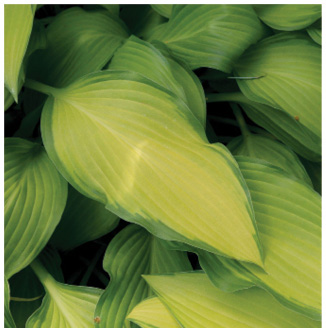
Pineapple Upside Down Cake hosta (Hosta ‘Pineapple Upside Down Cake’) A unique hosta to add to the shade garden. Long, wavy foliage emerges pure green, then the center turns brilliant gold and leaves develop a narrow green-black margin. (This scene captures it mid-transition.) In summer, lavender flowers held high on 2-foot-tall scapes will attract hummingbirds. Grows to 18 inches tall and 4 feet wide in zones 3–8.

Leopard’s bane (Doronicum orientale ‘Magnificum’) This golden yellow daisy is a welcome sight in spring, thriving in average or moist soil and sun or partial shade. This perennial may go dormant during the hot summer weather, so add companion plants that will fill the gap. Grows to 2 feet tall and wide in zones 4–7.
SITE SHADE, PARTIAL SHADE SOIL MOIST ZONE 6–9 SEASON YEAR-ROUND
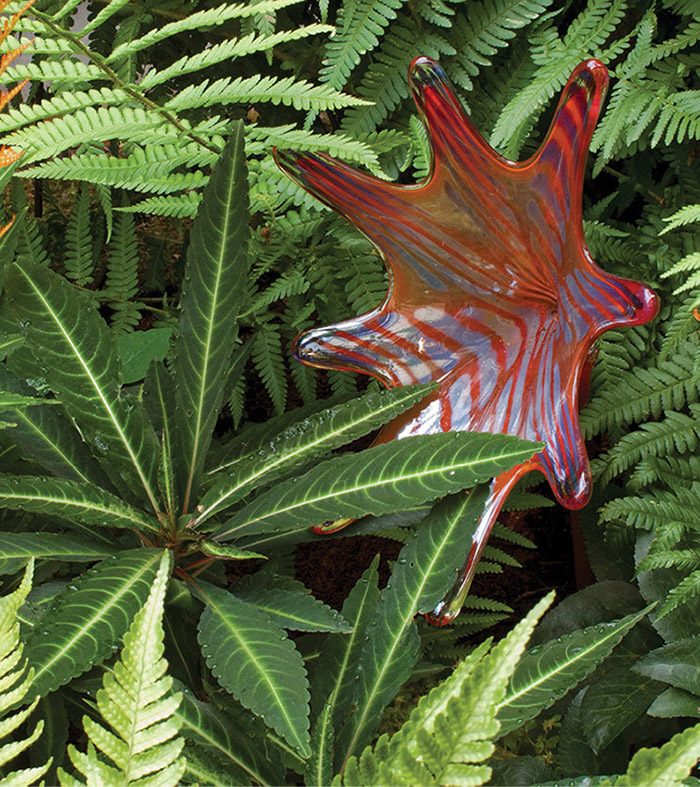
Purchasing garden art is the easy part. Knowing where to put it so you enhance both the art and the garden takes a little more practice, but it is really just observation of the smallest detail. Both the colors and shape of this glass piece provided the design inspiration. The hardy impatiens foliage echoes the star silhouette, a combination made even more striking because of their similarity in size. There is a more subtle connection between the orange striations in the glass and the distinctive veins that culminate in deep rose at each leaf node.
Hardy impatiens is a herbaceous perennial that has attractive foliage from spring until fall with attractive snapdragon-like yellow flowers appearing at the end of summer. The color of these blooms could be enhanced with an adjacent planting of All Gold Japanese forest grass (Hakonechloa macra ‘All Gold’), while autumn fern (Dryopteris erythrosora) would repeat the copper tones of the glass and be an evergreen year-round partner. The glass is frost-proof; you can leave it outdoors year-round in temperate climates, but it is best protected in colder regions.
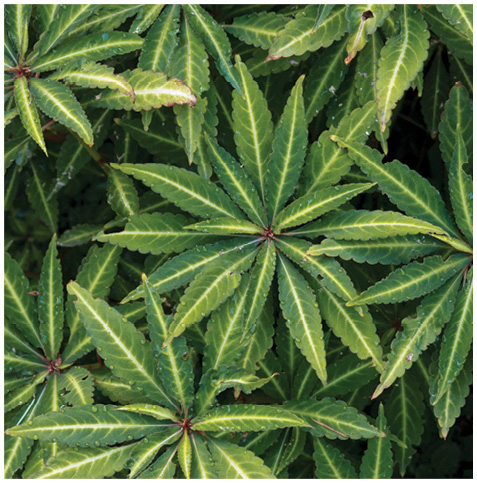
Hardy impatiens (Impatiens omeiana) Whorls of pointed dark green leaves are held 18 inches high on dark red stems. Each leaf has a bright yellow vein that helps to make this stand out in shady areas, and in late summer yellow flowers echo this feature. This herbaceous perennial spreads easily from rhizomes to form a ground cover in zones 6–9.

Glass starburst You can place glass art in the garden using rebar or copper tube as a stake. By adjusting the length, you can situate the piece at the perfect height to add artistic detail to a tall shrub or a low ground cover. However, nestling it into the surrounding foliage often strengthens the visual connection. In milder climates you can leave this out year-round, but in colder locales store it in a protected area.